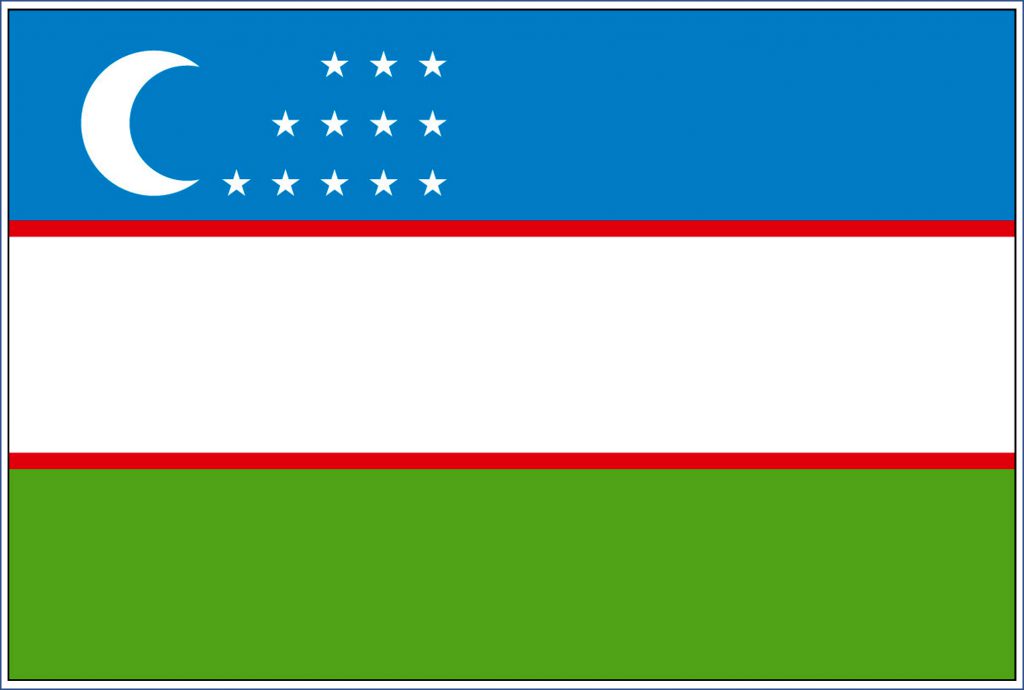
To Tashkent, Uzbekistan – Sept. 28
ElderTreks brochure: After breakfast, drive to the Uzbek border. After border formalities, we continue our drive to Tashkent. Upon arrival, enjoy a city tour of Tashkent with a visit to the Old city that includes the Khast Imam complex, Kaffal Shashi Mausoleum and Kukaldash Madrassa. We also visit the Museum of Applied Arts. Overnight in Tashkent: Wyndham Hotel.
The crossing from Tajikistan to Uzbekistan took around 45 minutes. There was a fair bit of walking between buildings and between countries but was all paved, maybe a mile in total. There were a lot of vehicles and people both leaving and entering each country.
There were signs saying that if a person was bringing into Uzbekistan more than $2,000 US (or equivalent in other countries’ currencies), it should be declared. As no one knew why, and a concern it might be confiscated, there was some discrete shuffling of money around while we were waiting in line from those who had more to those who didn’t! However, there was no personal search, although we all went through the standard airport-type scanner. Later I found out we needn’t have bothered.
Immigration into Uzbekistan was quick except for Leroy, took a long time before they stamped him in. I waited and waited outside in the hot sun as other folks from our group who were further back in line went by, and was walking back in to see what was going on, when he and Trish came on out. Initially, we surmised it was because his passport was so fat with all the extra pages, but mine is too and I just got passed right through. Trish said several of the officers tugged on the pages; however, Roger said they’ve seen bulky passports before unless he’d had inexperienced immigration officers. On the bus as Leroy was examining his passport, he noticed he didn’t have a beard (and was 10 years younger) in the photo. He looks a lot different now. That might be the reason for the delay, or part of it as it doesn’t account for the page tugging, we’ll never know.
I asked Roger during lunch if he knew why there seemed to be a limit on cash being brought into the country Didn’t make sense to me–the more brought in, the more could be spent. It had something to do with selling on the black market, bit too complicated for me to follow. If one does leave with more than one had entering, bank documents must be produced showing the source of the additional currency. He told me that, out of necessity, he carries a lot of cash, declares it, it is counted and a record made of the amount. Routine for him. The money will be counted again when he leaves Uzbekistan to make sure it doesn’t exceed the amount he had when entering.
After a short walk from the immigration building, we waited in two lines at Security, no problems, and finally outside again, happy to see a man holding an ElderTreks’ sign. Our new bus is big and luxurious.
Tashkent has a population of more than six million people. Over 60% of the people use public transportation–no traffic jams! When we arrived in town, before checking into the hotel, we visited several places and had lunch.
First we visited a mosque or mausoleum but I can’t remember the name.
Then we went to the State History Museum, a “through the ages” history of the area, beginning with the Neolithic era and progressing through to modern times and Czarist and Soviet era history, formation of the Republic, and so on.
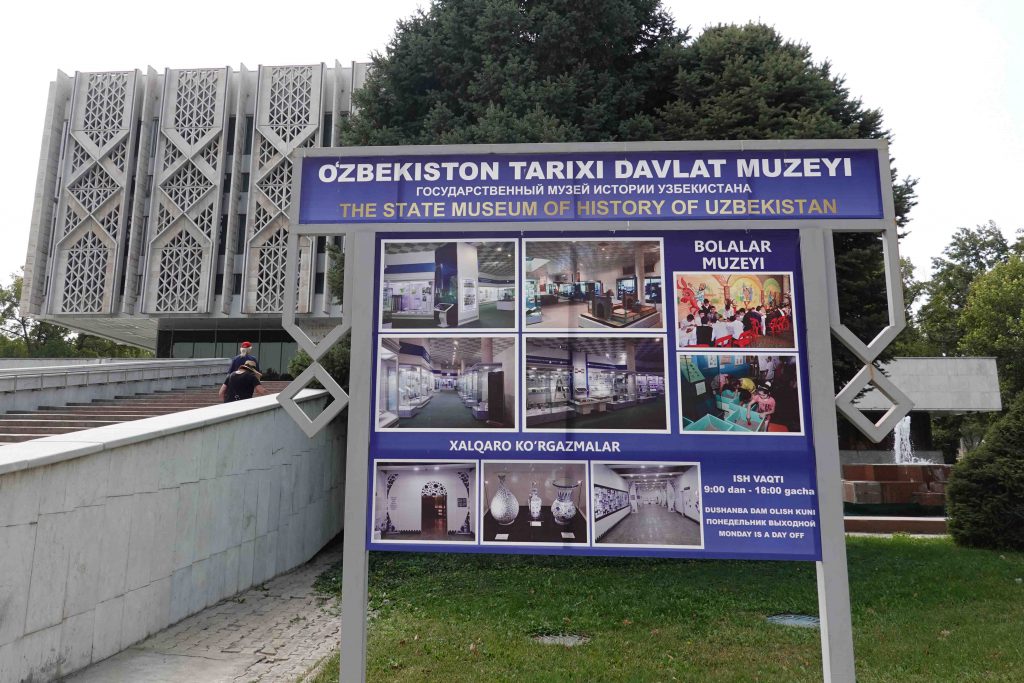
After than, the Museum of Applied Arts. Some gorgeous items.
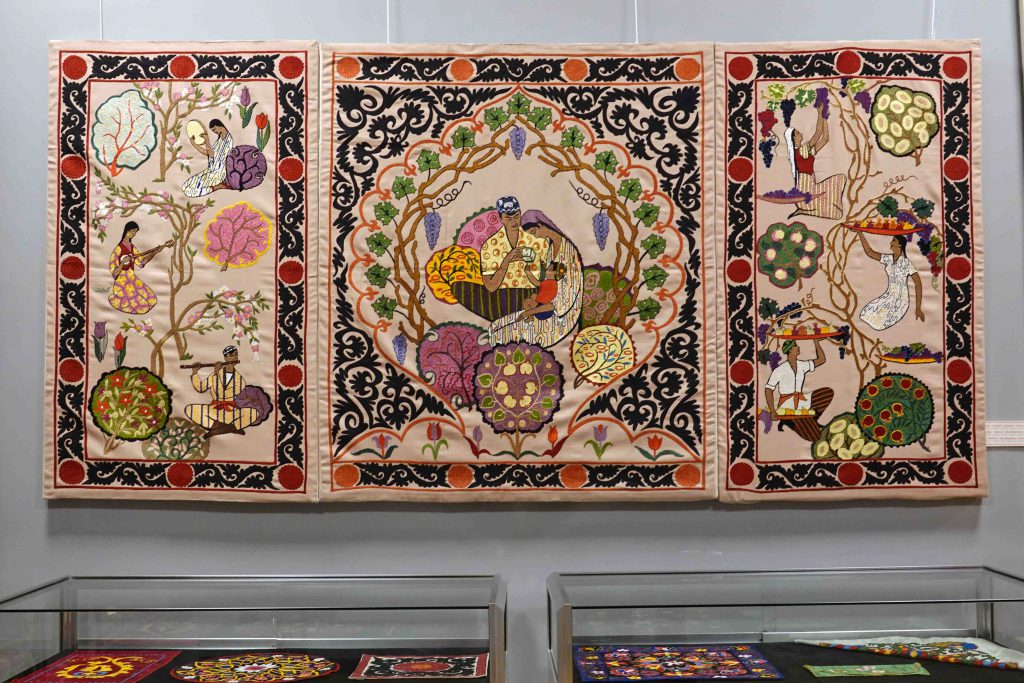
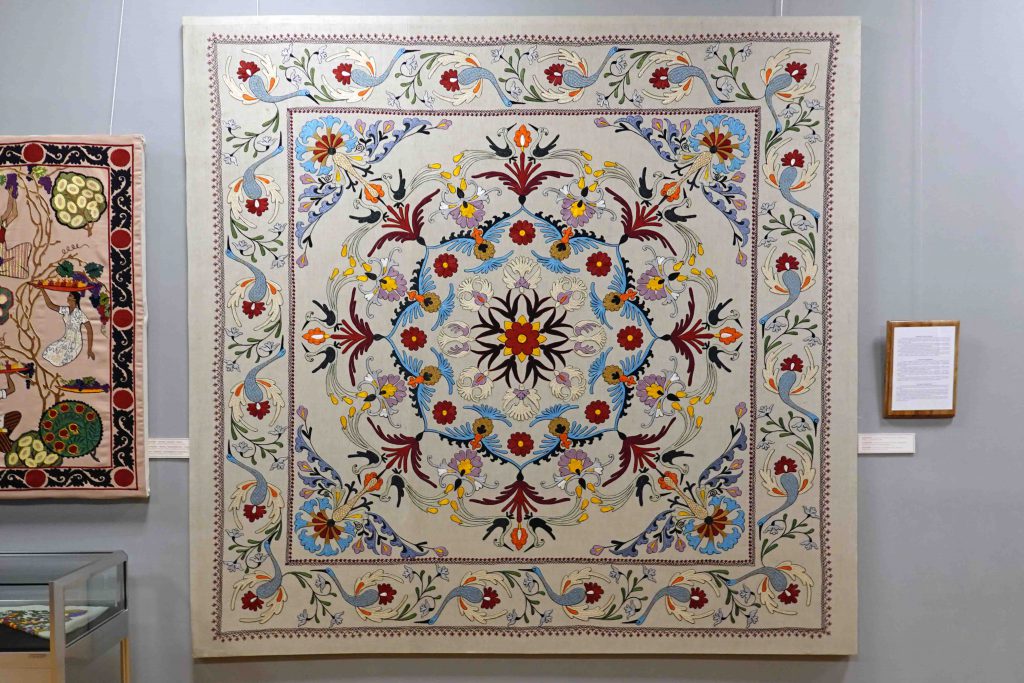
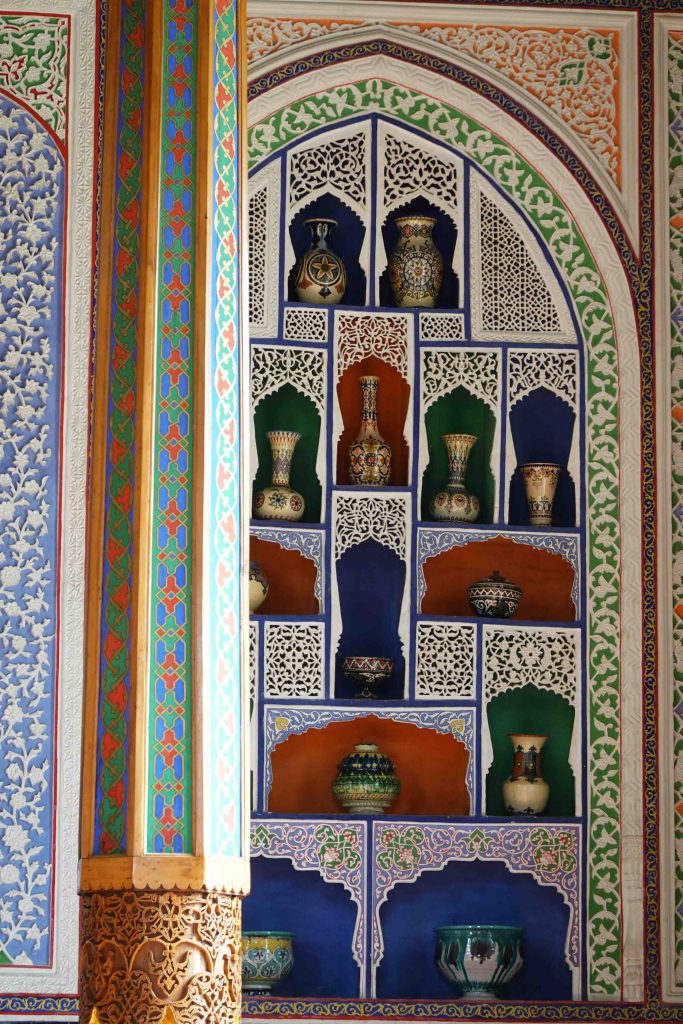
Our last stop, was the Khast Imam complex of buildings, impressive and quite restful feeling.
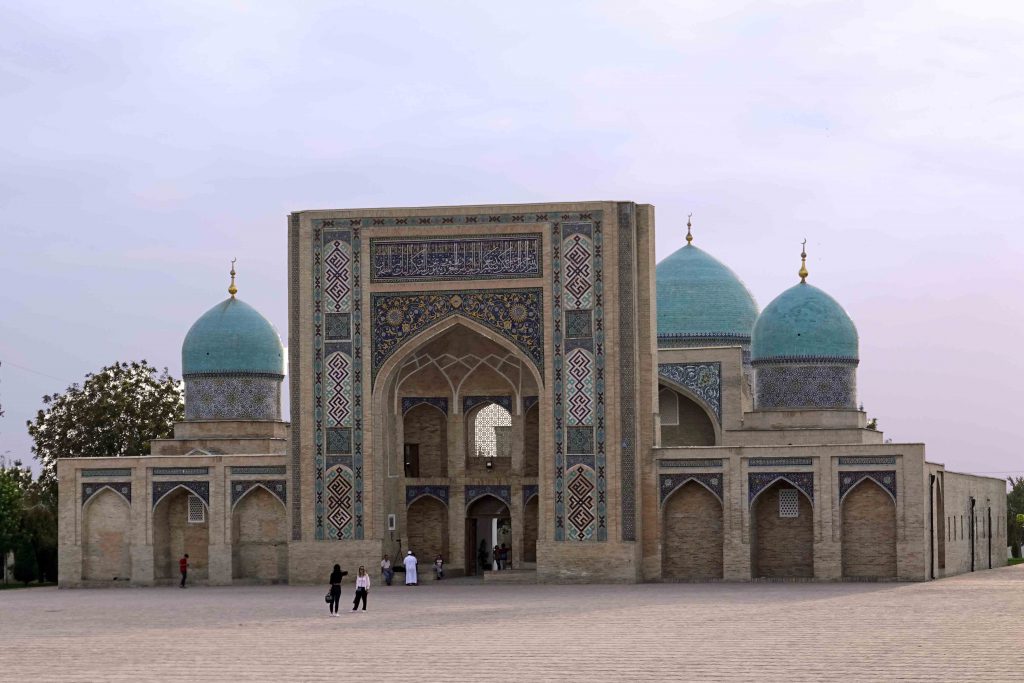
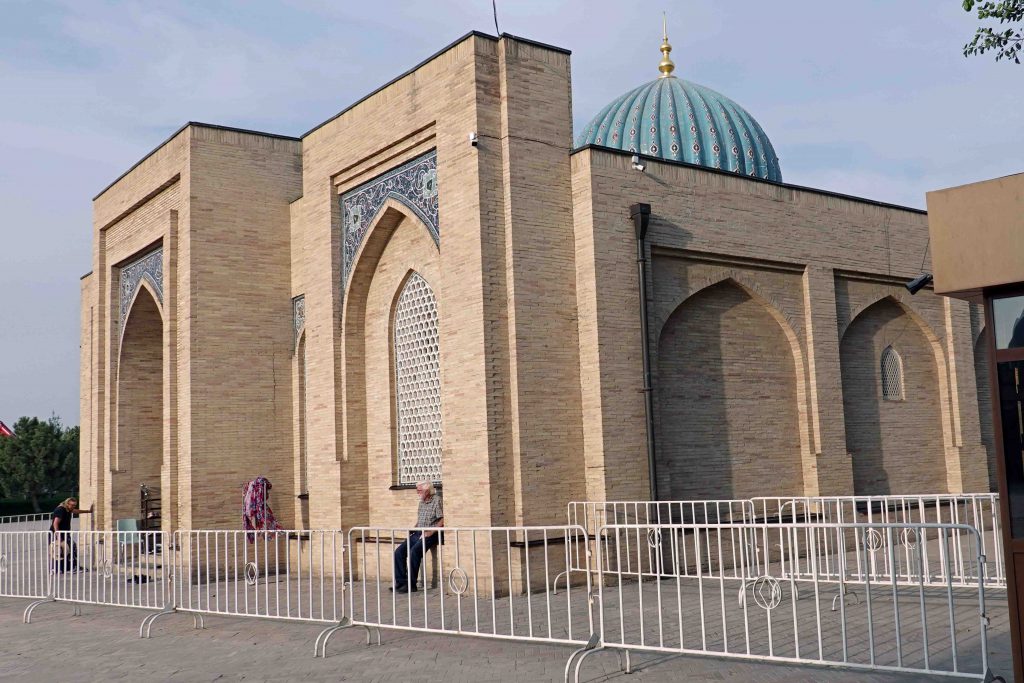
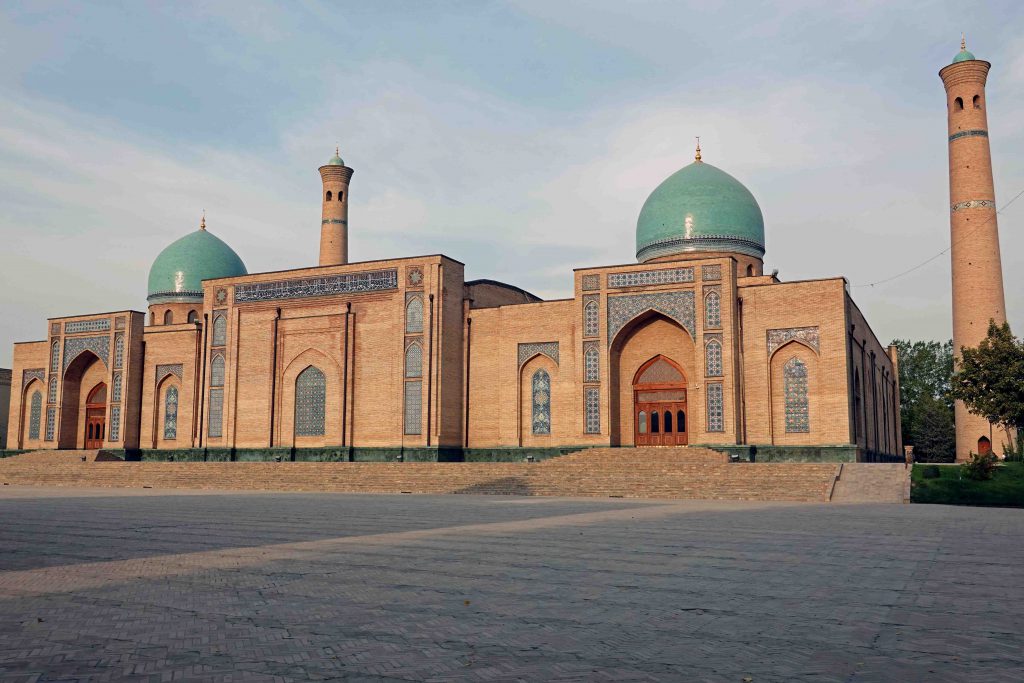
By the time we got to our hotel, I was desperate for a cappuccino and bought one when we arrived–33,350.00 som. 33,350.00 som!!! That amount is worth three asterisks. But that’s only $3.54–ha ha.
Once again, I was exhausted and not hungry enough to want to go out to eat a late dinner. Leroy said the Greek Salad was tasty and the beef was the best of the trip.
Fun names on the toiletries. I always want a “Good Hair Day,” and felt tempted to add “and Carry On” to the soap.
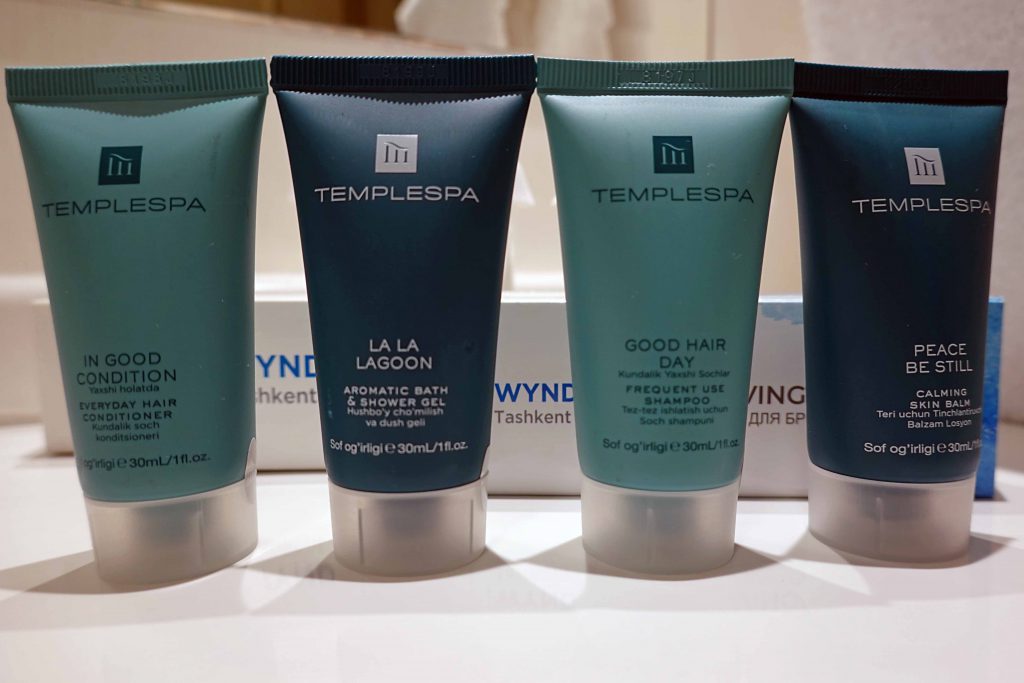
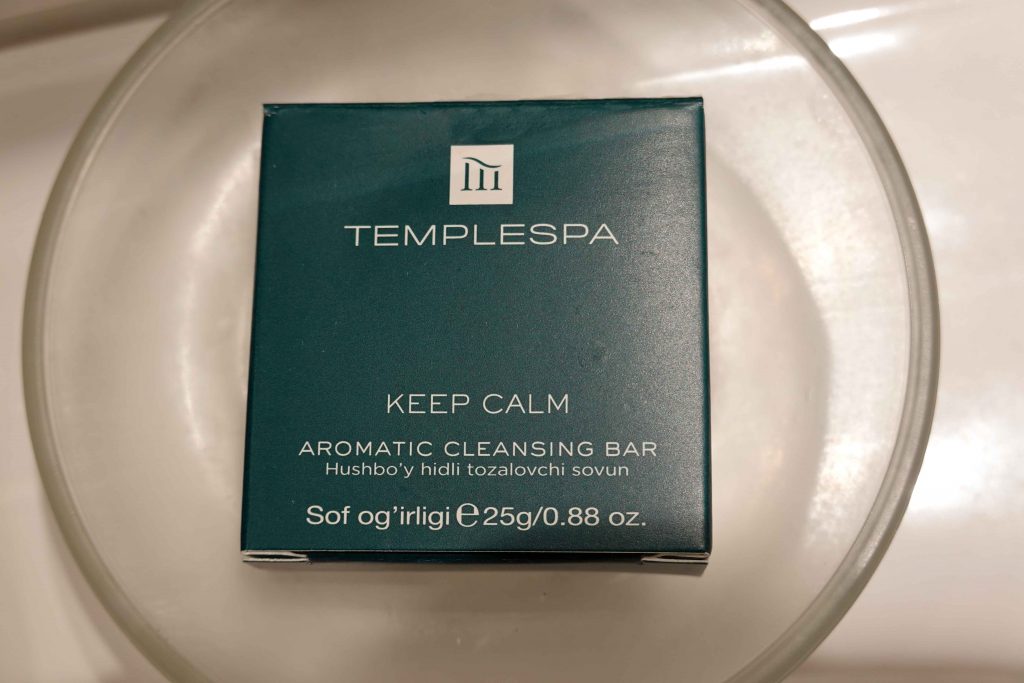
To Samarkand – Sept. 29
ElderTreks brochure: This morning we visit Independent Square, Navoi Theatre Square and Amir Temur Square. After lunch we depart for Samarkand. The historic town of Samarkand, recently declared a World Heritage Site, was and still is a crossroads and melting pot of world cultures. Founded in the 7th century BC as ancient Afrosiab, Samarkand had its most significant development in the Timurid period from the 14th to the 15th centuries. Overnight in Samarkand: Asia Hotel.
A last look around Tashkent, Uzbekistan, before we head out this afternoon for Samarkand.
Elaine bought a top yesterday at the Museum of Applied Arts, and wore it today–it looks very nice indeed, and cool, which was needed toward the end of our morning sightseeing.
We started off with Independence Square. Surrounded on all sides with government and administrative buildings, it has colonnades, fountains, and beautiful park areas. It is a lovely place. We couldn’t get close to the Monument to the Independence of Uzbeckistan as improvements were being done to that area, so this is photo from a distance. Where the globe is now used to be a huge statue of Lenin.
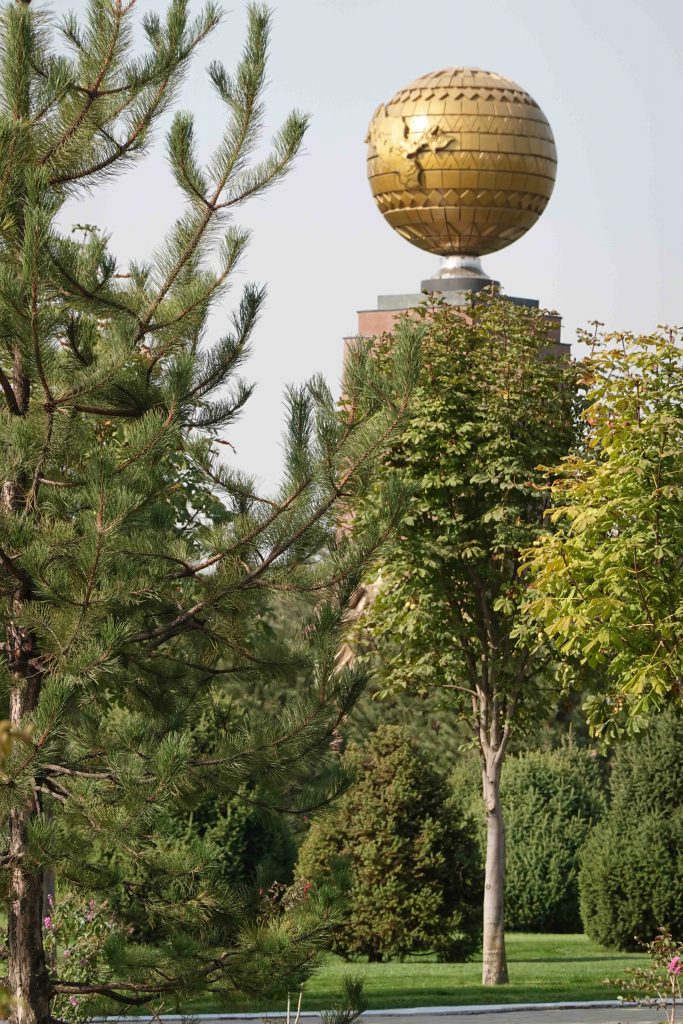
The gallery which led to the memorial with the eternal flame has alcoves on the closed side (left side in photo below) holding metal books engraved with the names of the 400,000 Uzbek soldiers who died in WWII. Impressive and moving.
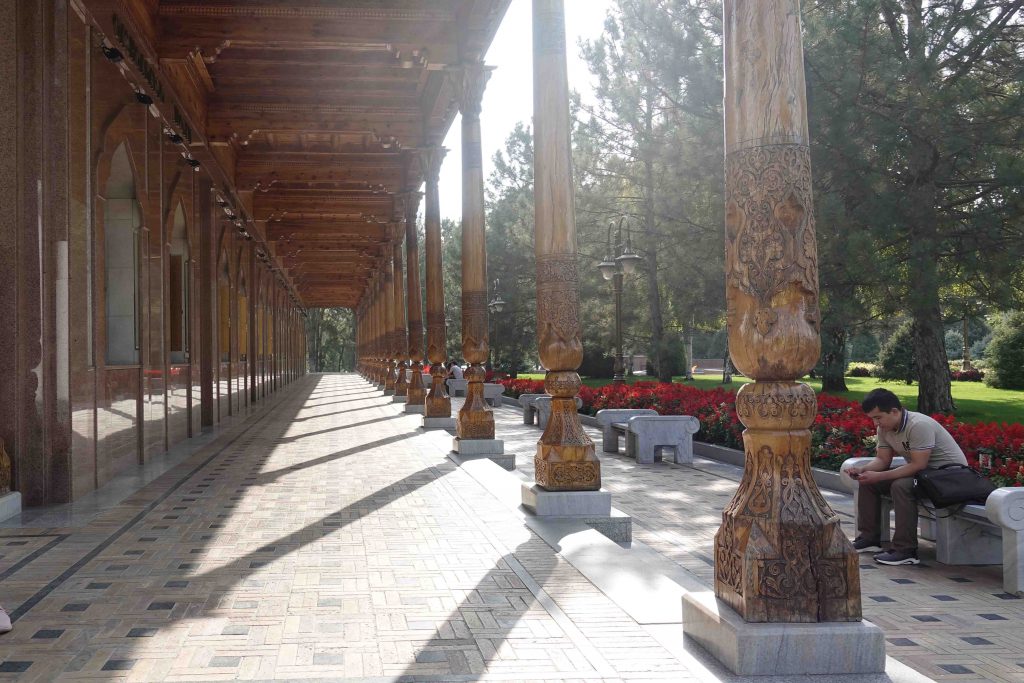
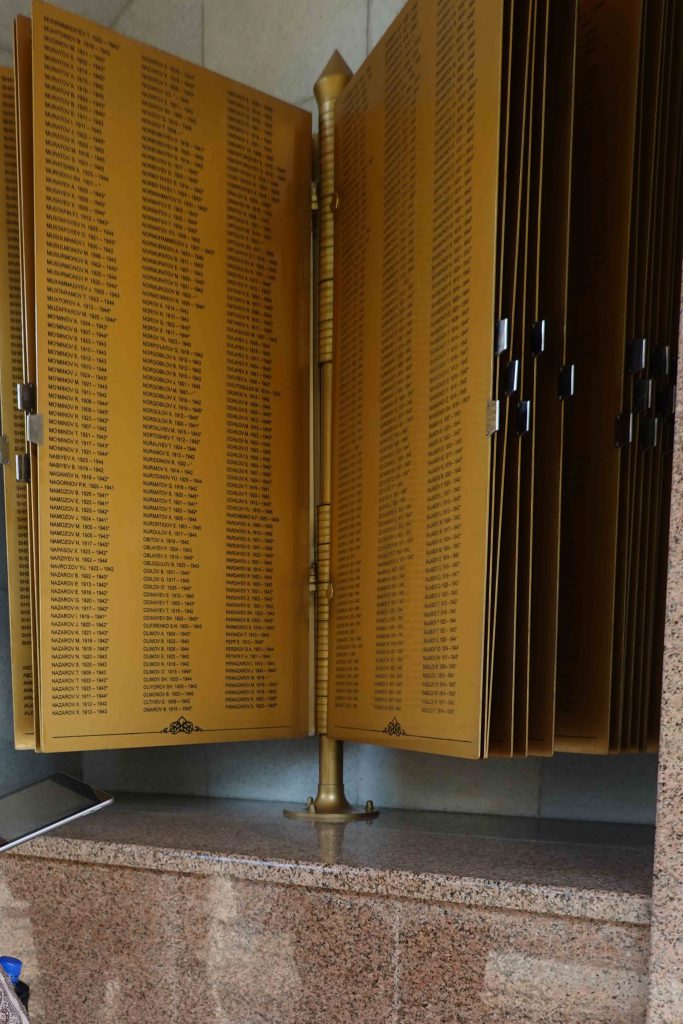
Storks taking flight adorn the ‘gates’ of the main entrance to Independence Square, Ezgulik Arch (the arch of good and noble aspirations). They symbolize and celebrate the rebirth of the nation.
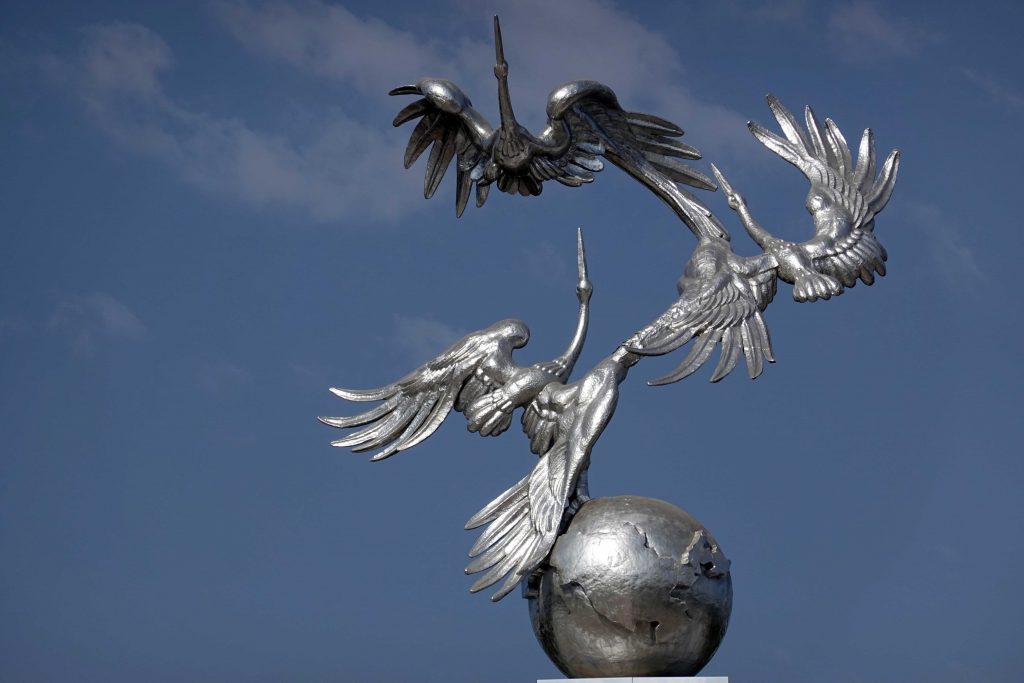
Among other sites, we saw Navoi Theatre, Amir Temur on his horse, and took a trip on the underground/subway.
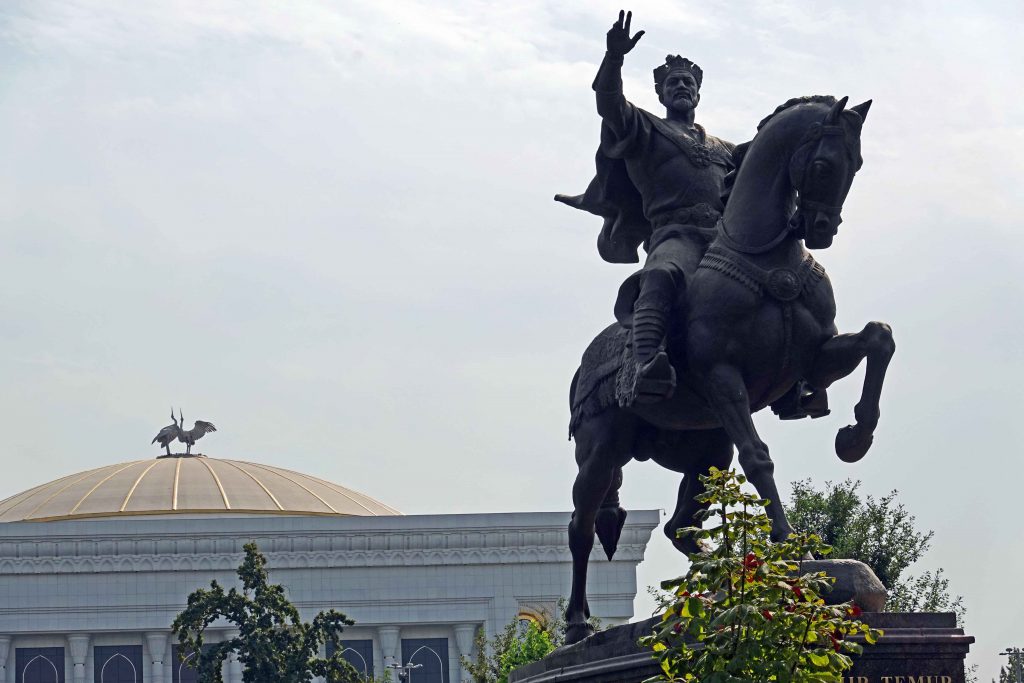
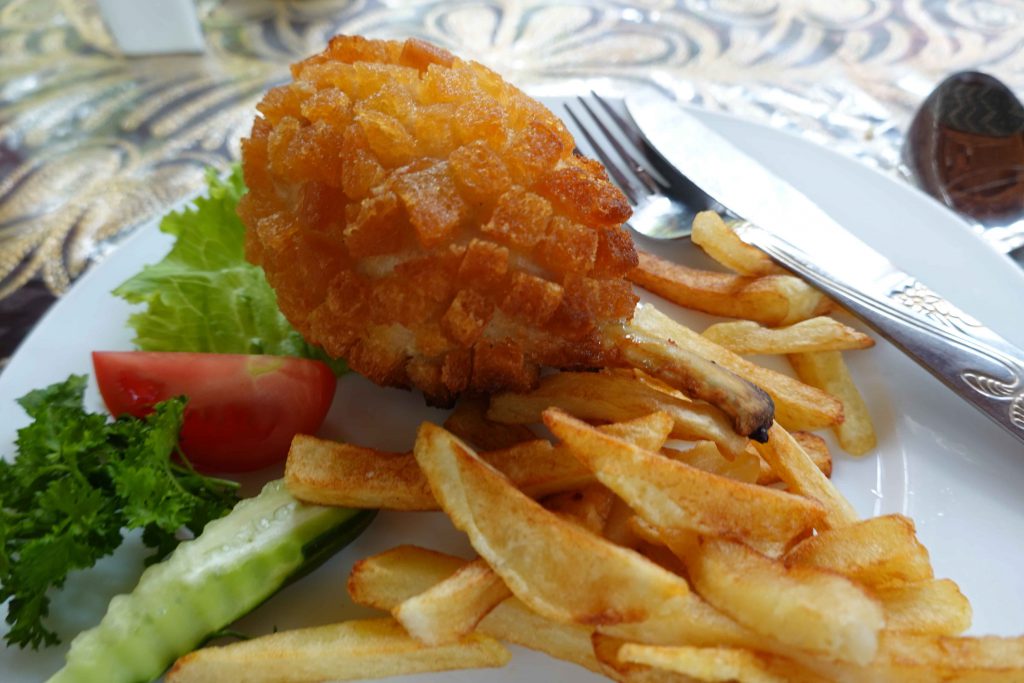
Lunch…..
….. then a five and a half hour drive to Samarkand, a very nice dinner, wrote today’s blog entry, and now to sleep. We’re going to have a very full and strenuous day tomorrow.
Samarkand – Sept. 30
ElderTreks brocbure: On our city tour of Samarkand we visit Registan Square, the heart of ancient city, Temur’s burial place; Mausoleum Gur Emir and famous Bibi Khanum Mosque, which intended to out-rival everything Tamerlane had ever seen. We also visit Shakhi Zinda necropolis, Ulugbek observatory and the Silk Paper Center. Overnight in Samarkand: Asia Hotel.
Exhausting day, my legs feel like they’re going to fall off! But very well worth it.
Roger, our ET tour guide, has Tamerlane’s Revenge.
“Although known primarily as the burial place of Timur (Tamerlane), Gur-Emir was begun by Timur in 1403 to commemorate the death of his beloved grandson, Muhammad Sultan. His sudden death at the age of 27 deprived Timur of his chosen successor. The shrine was not yet completed at the time of Timur’s own death from pneumonia in 1405. With his burial there, Gur-Emir became the Timurid mausoleum. The interior was completed by Timur’s grandson Ulugh Beg, also buried at Gur-Emir.” https://www.wdl.org/en/item/3574
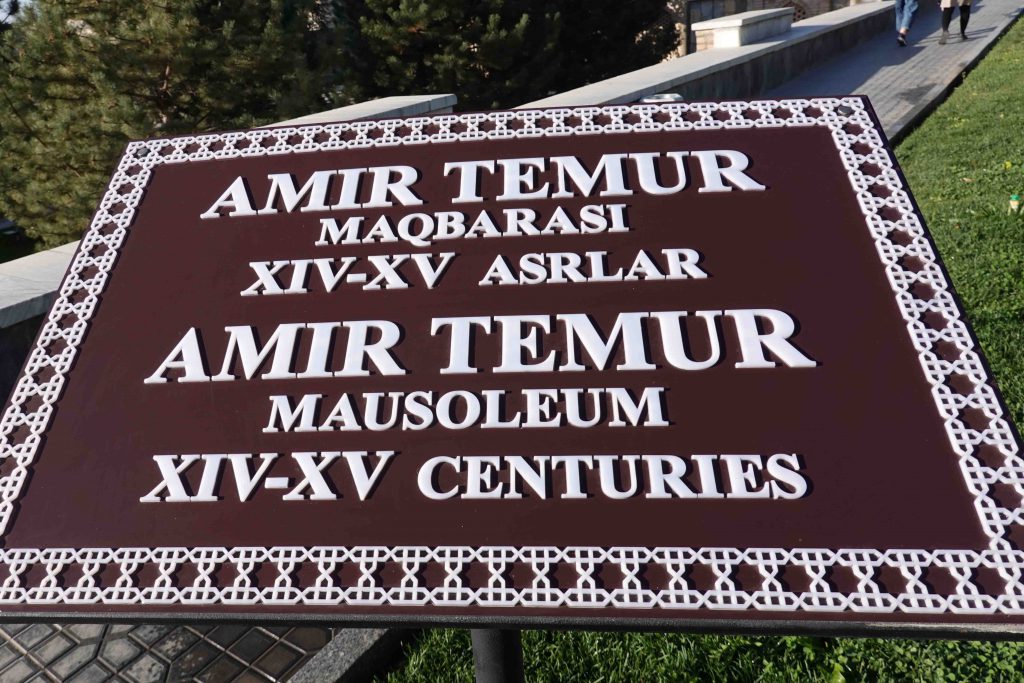
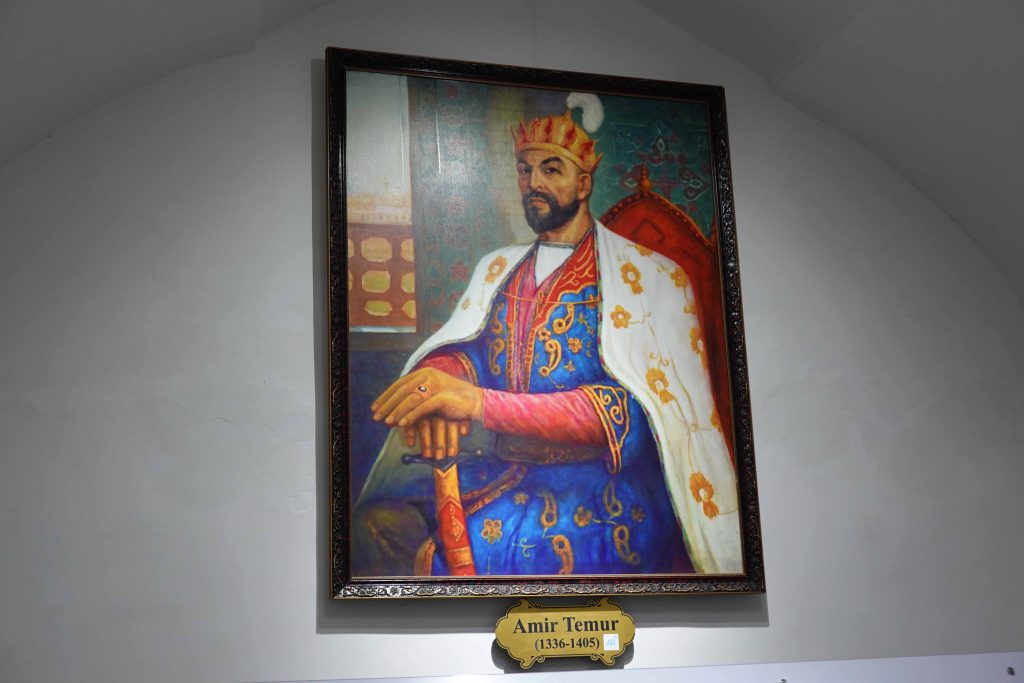
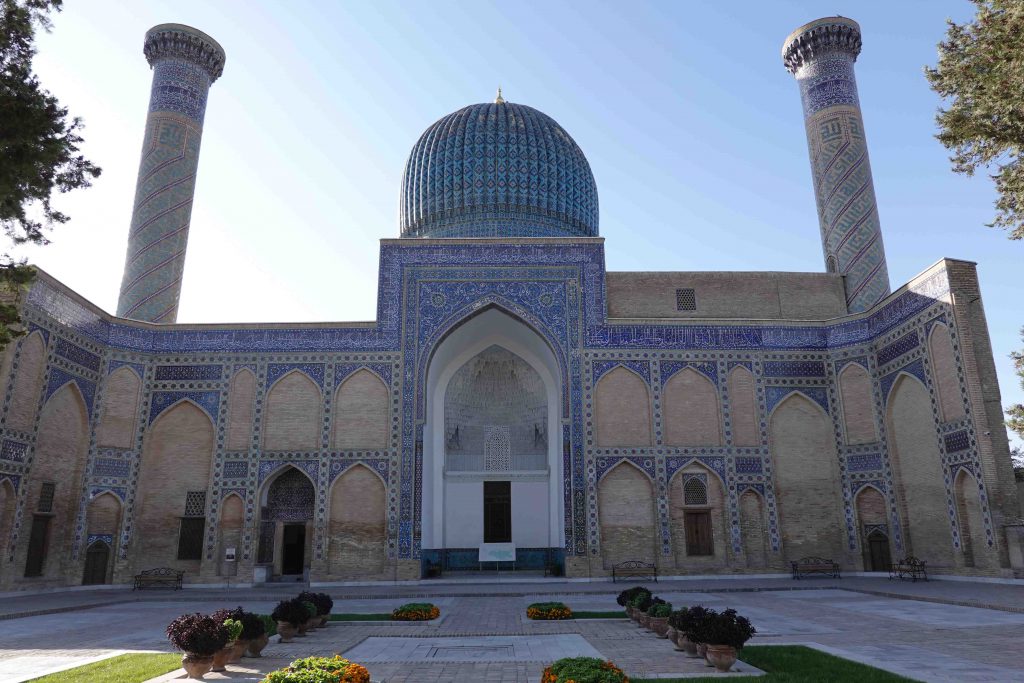
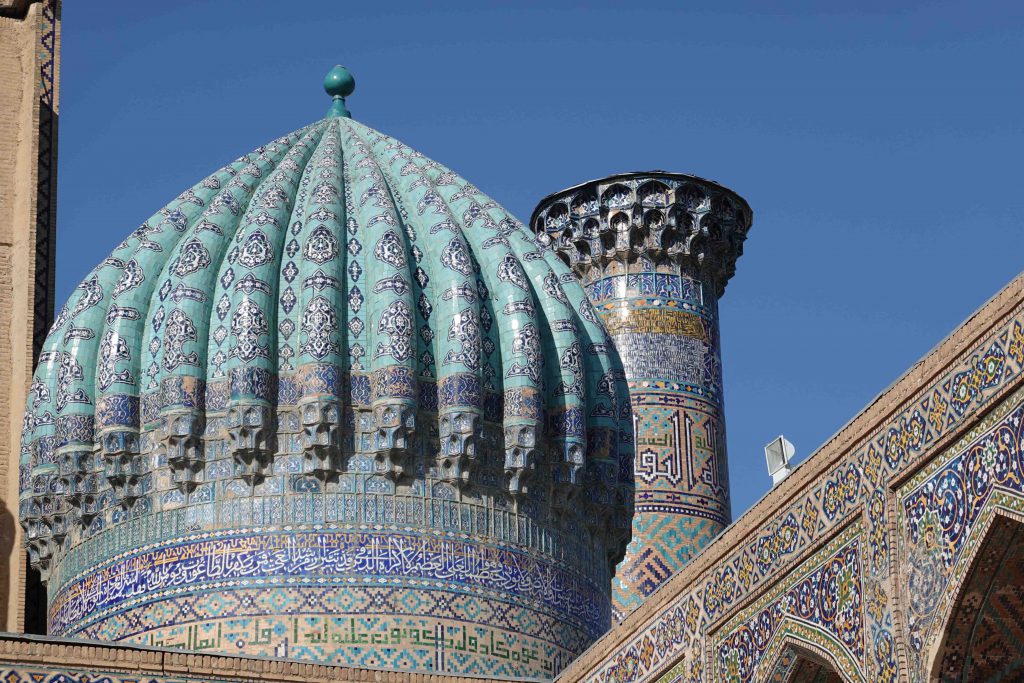
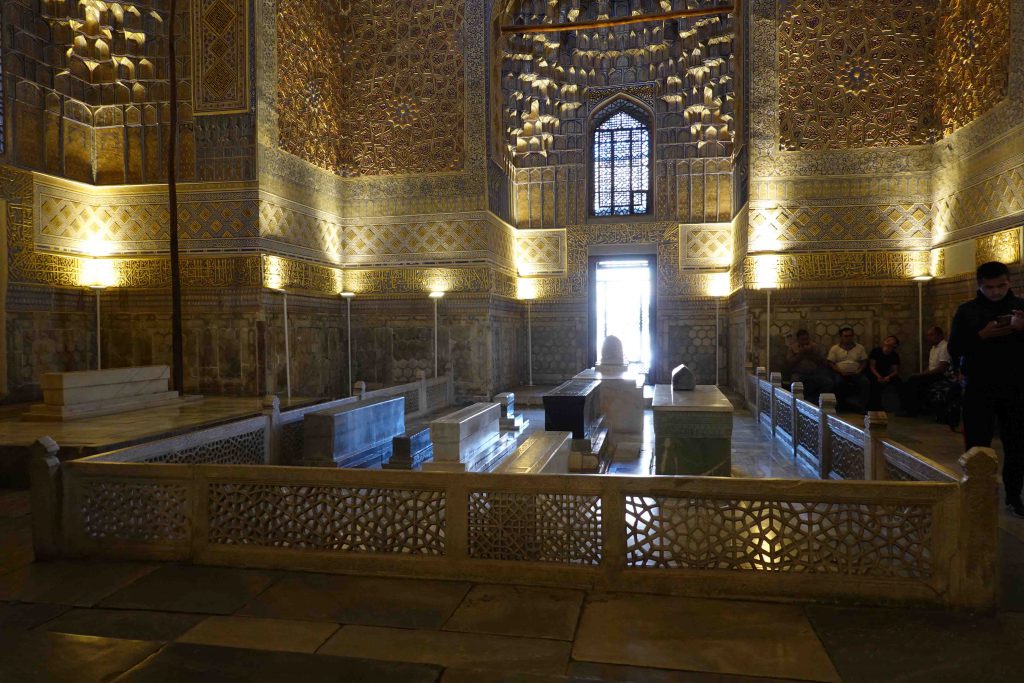
After Amir Timur mausoleum, we went to Registan Square. It’s surrounded on three sides with madrassas (below), the entrances to which are facing the center of the space. All three have their own unique decor. Ulughbek Madrassa, left; Sher-Dor Madrassa, right; Tilla-Kori Madrassa, center.
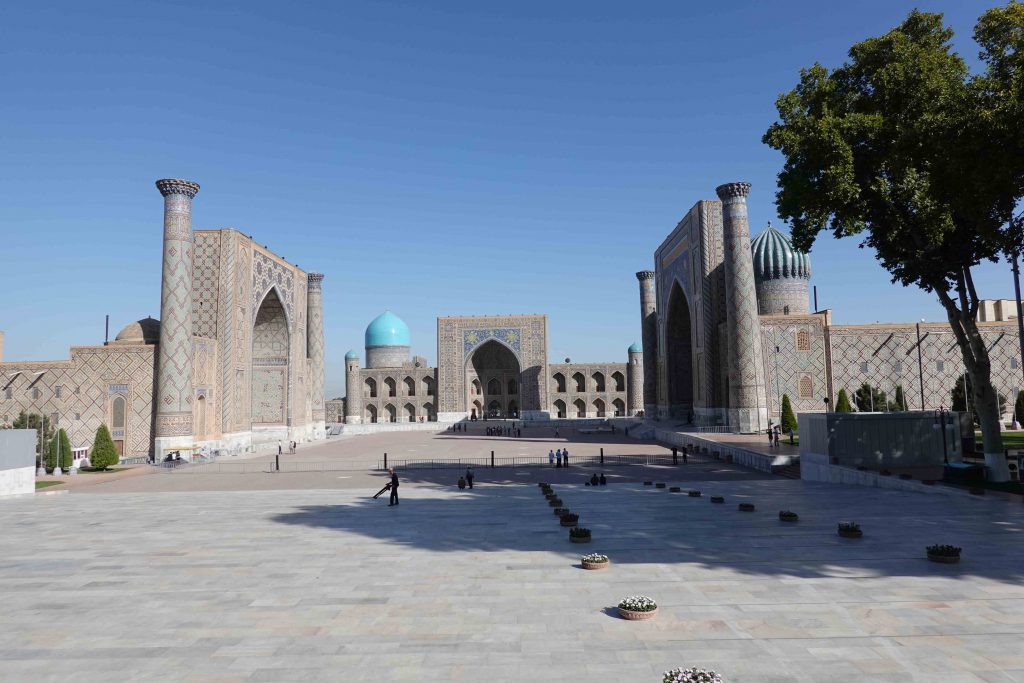
Then on to the Bibi Khanum Mosque. It was a long walk to this mosque in over 100 degree (Fahrenheit) heat, somehow especially more when we saw schoolkids and young people zooming by on people-movers that run the length of the road. Our guide, Helen, took pity on us and rented a couple to take us back.
She said that legend has the mosque was built by the Tamerlane’s favorite wife, Bibi-Khanym, in honor of his return from a trip to India. It was planned to be the biggest and best in Samarkand. The architect fell in love with the queen and delayed the completion of mosque. The queen asked the architect to hurry with the construction of the mosque and he said the only way it would be ready in time for Timur’s return was if she allowed him to kiss her. The queen reluctantly agreed with this, but his kiss was so hot it left a bright trace on her cheek.
When Timur returned, he was delighted with the gift from his wife but noticed the remains of the kiss on the cheek of his wife. There are various endings to this story, all have Tamerlane killing the architect. One says he had the architect thrown off one of the towers but he turned into a bird and flew away.
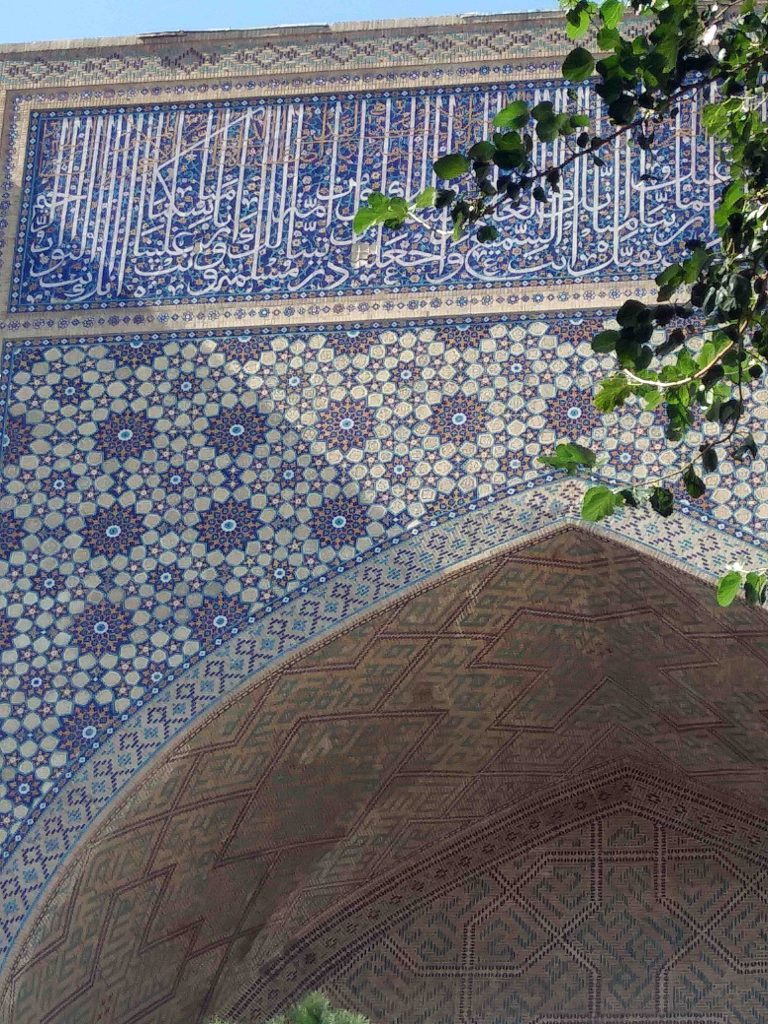
We had a brief but very interesting introduction to several musical instruments, all made of mulberry wood.
After lunch, we went to the Silk Paper Center. The paper is not made from the silk from silk worms but from the leaves of the mulberry trees they eat.
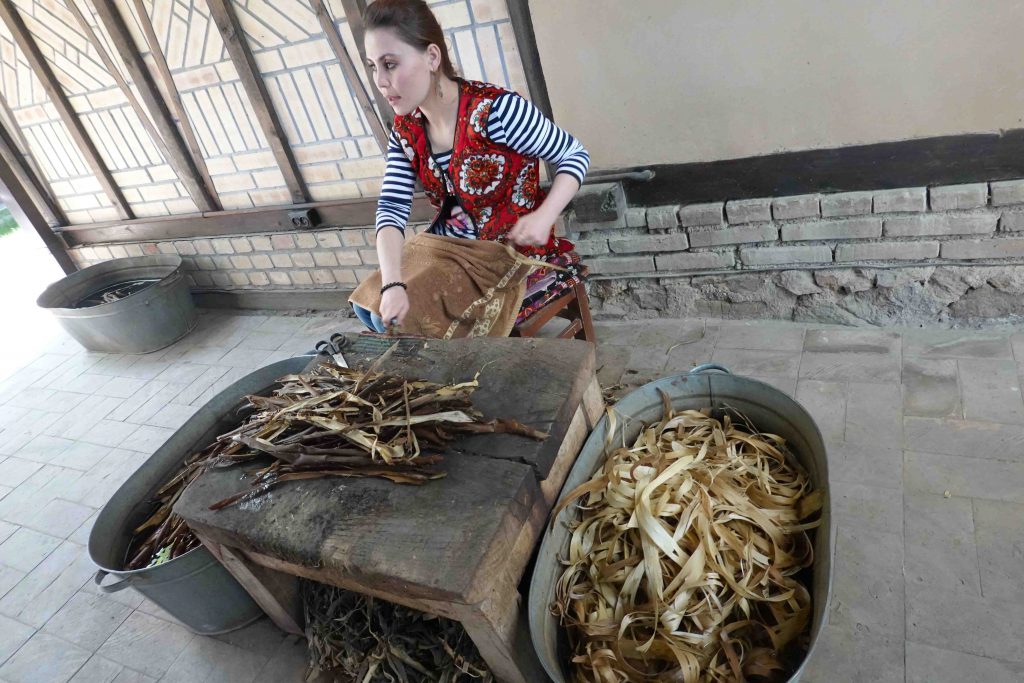
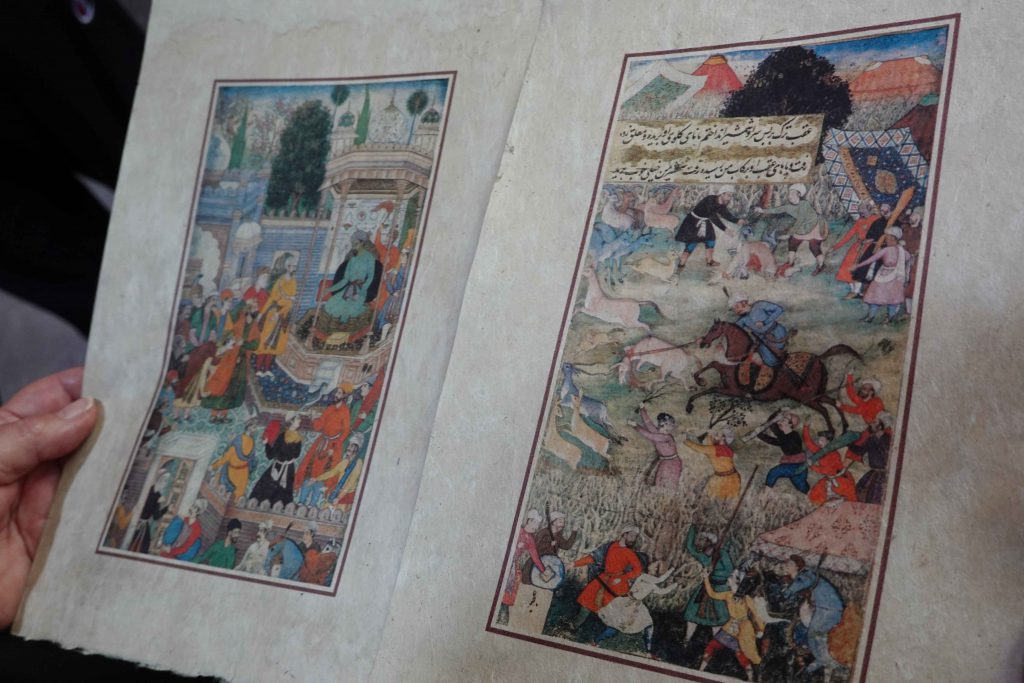
Ulugh Beg Observatory was built in the 1420s by Ulugh Beg, grandson of emperor Tamerlane. It was here a year was measured at 365 days, 6 hours, 10 minutes and 8 seconds, only about 1 minute longer than modern calculations. After being destroyed by religious fanatics in 1449, it was rediscovered in 1908.
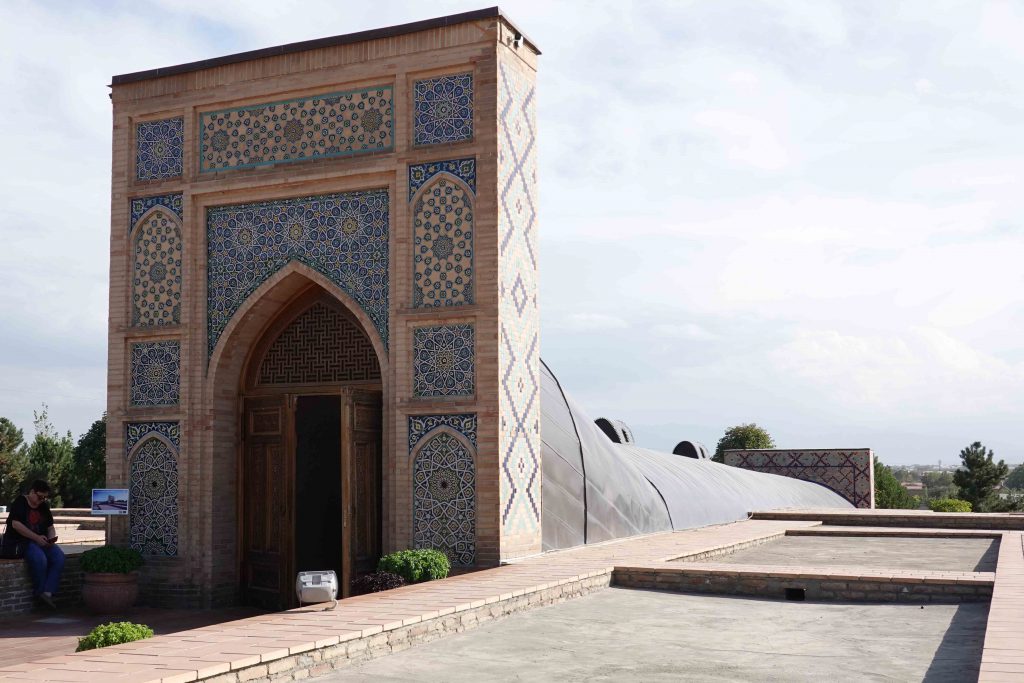
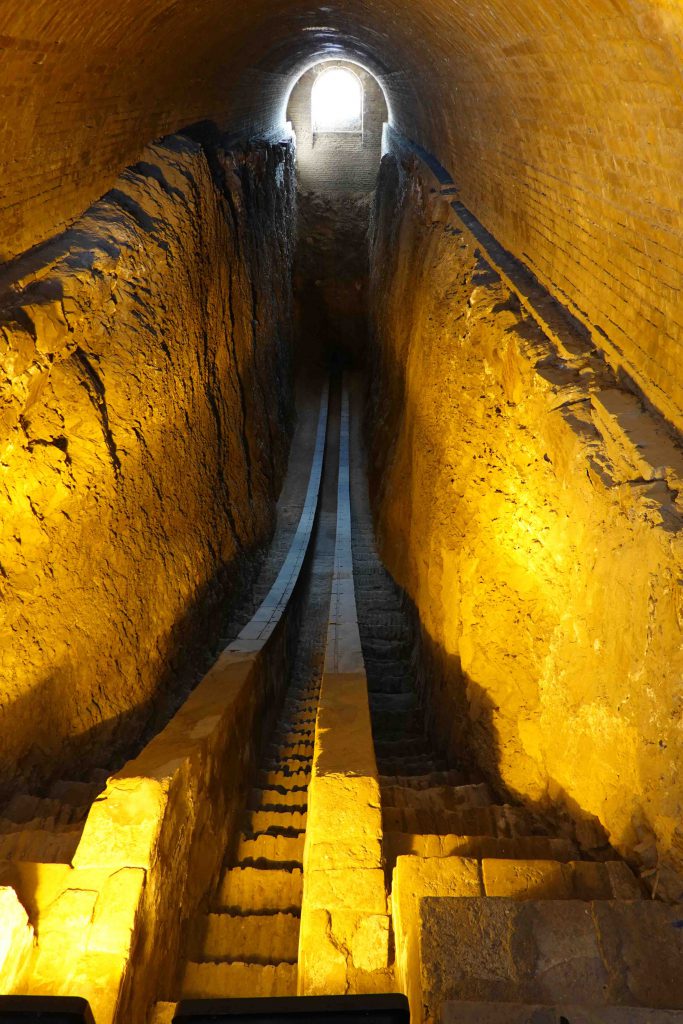
Shakhi Zinda necropolis has 11 mausoleums along a narrow street. They were built one after another in the 14-15th centuries. It was a grueling climb up the steps to it, but well worthwhile once there. It’s not that there are so many steps, just 41 or 42, earlier in the day I climbed up 60 without huffing, but the depth and width of them.
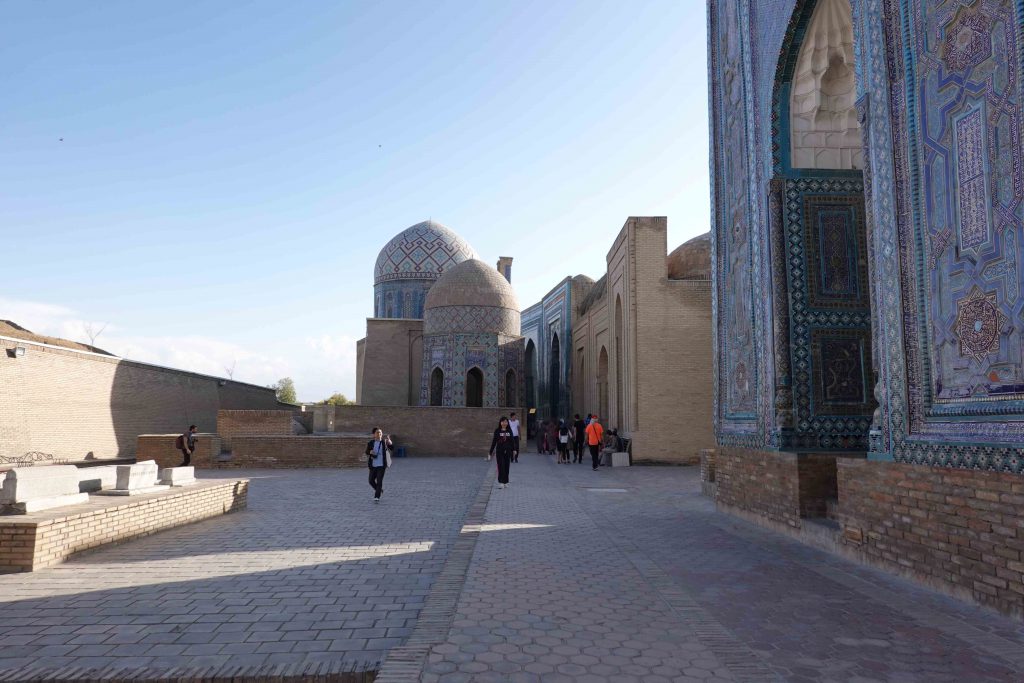
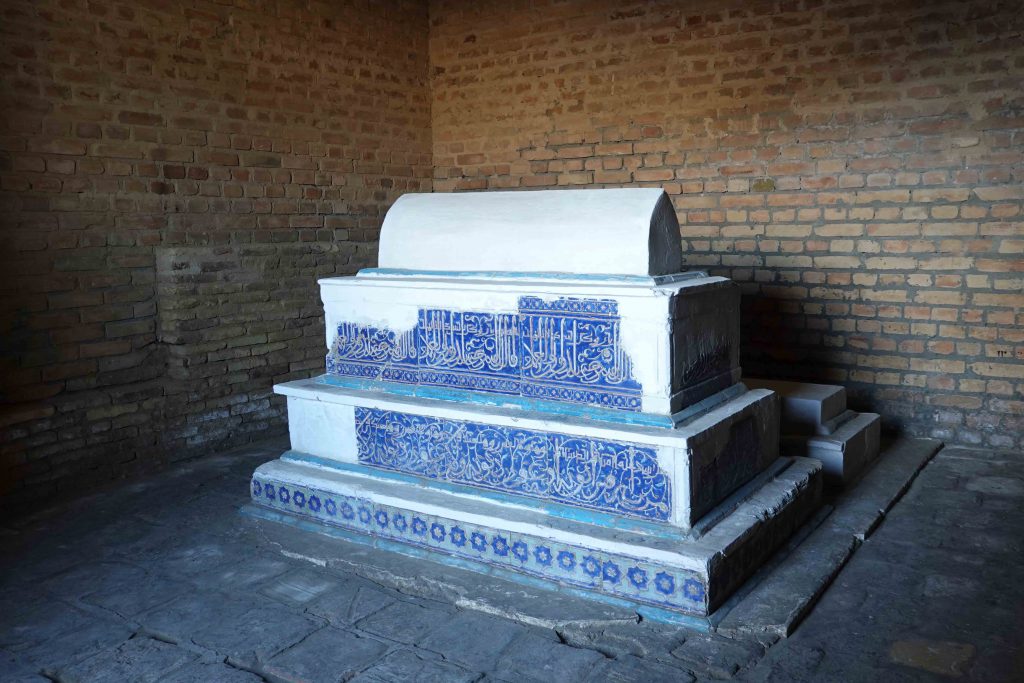

Leroy and I chose not to go out to dinner but instead to eat lightly, earlier and therefore missed viewing the night lighting–Trish got this great photo.
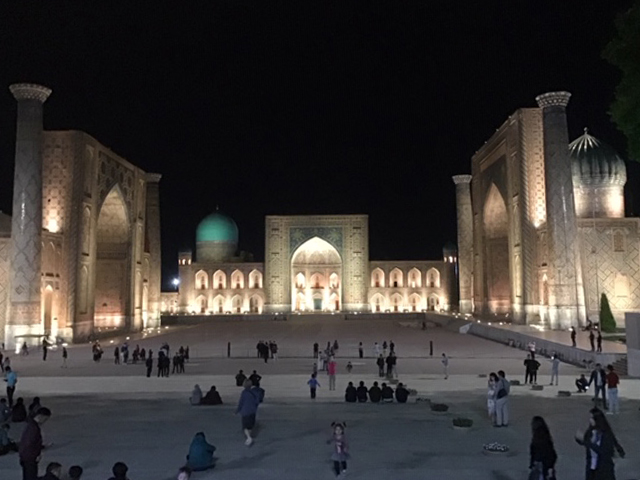
To Bukhara – Oct. 1
ElderTreks brochure: Depart this morning by coach to Bukhara, regarded by many to be one of the most cultural and evocative cities in the world. Depending on performance schedules, we may have the opportunity to enjoy a puppet show. Puppet shows were popular entertainment in public places, festivals and at private family celebrations in past times. Overnight in Bukhara: Asia Hotel.
Samarkand area gets around 2″ rain a year and Helen, our local guide, was surprised to see rain this morning as it usually doesn’t start until November then will rain continuously for several days. They also have some rain in the spring.
Even though this was a travel day, from Samarkand to Bukhara, it has been a most delightful day. Departed 8 a.m. and arrived 5:30-ish, with several stops along the way.
At one we bought ice cream bars all of us–Trish, Elaine, Leroy and me–read as Kit Kat (like the candy bars). Now I’m looking at photos for this Post, I see it is Kit Kit. Fooled us! They did taste good, though.
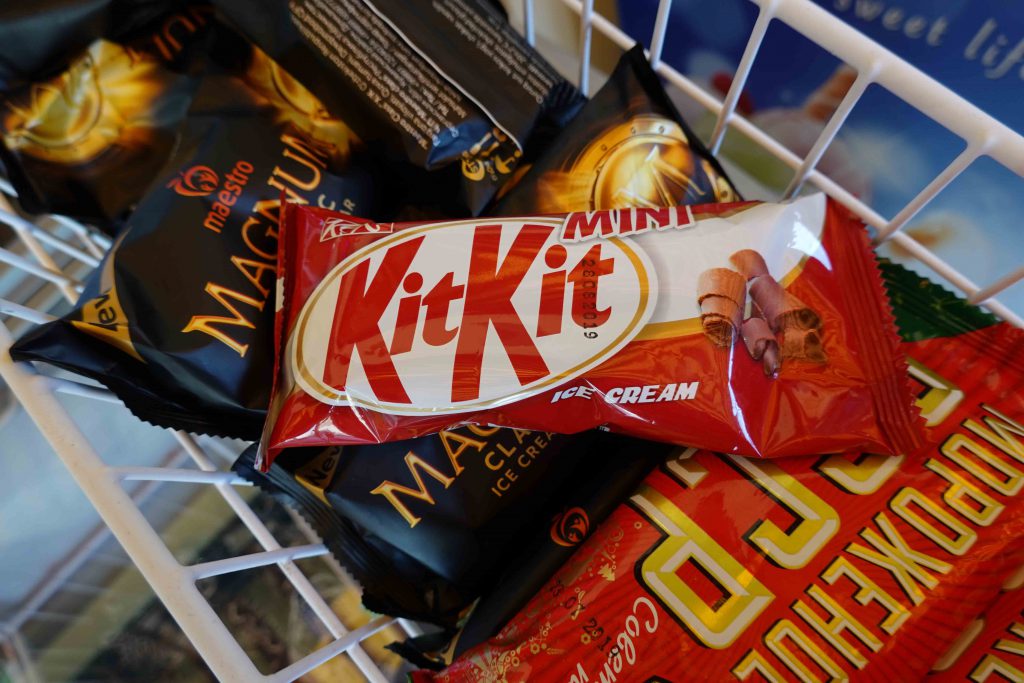
We stopped at a caravanseri and water well, along with other people traveling the road, and it brought to life the traders plodding along on their camels and horses so long ago.
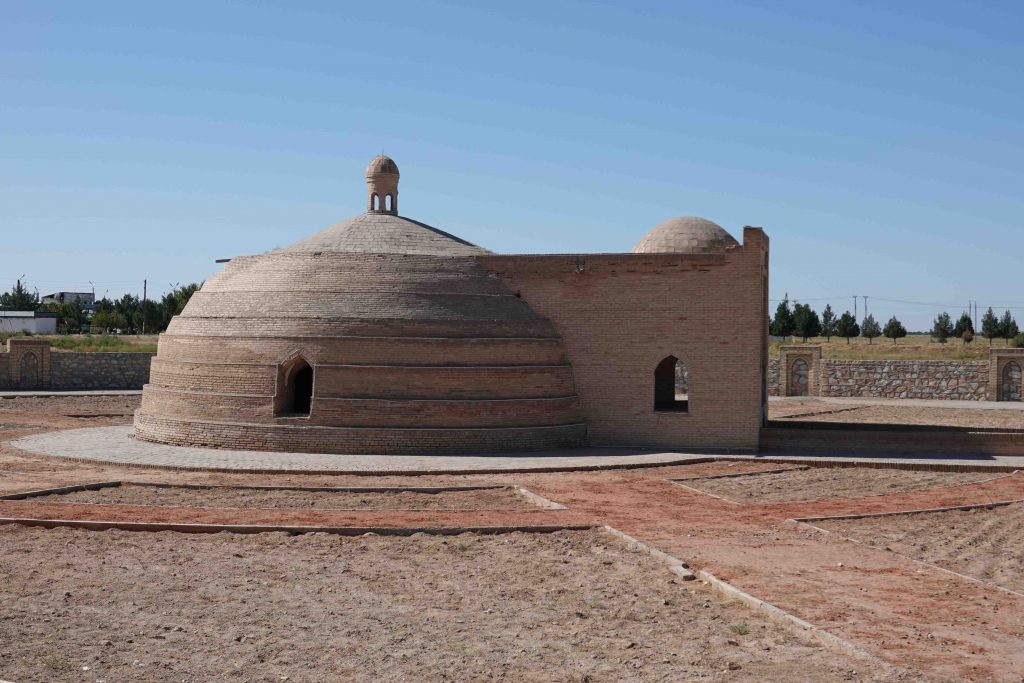
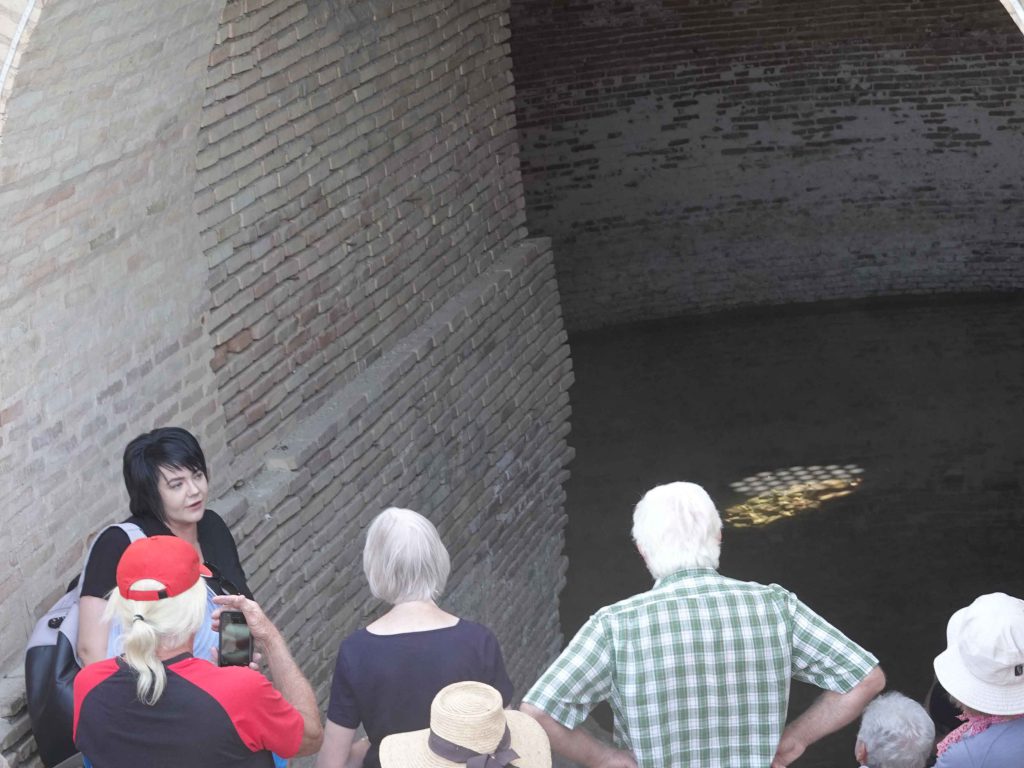
When we got to Bukhara we visited the Summer Palace. This countryside residence of the last emir of Bukhara, Mir Sayyd Muhammad Alim Khan was built for him by the Russians in 1911. The emir’s wife died young, and in memory of her he named the palace Sitorai Mokhi-Khosa (star-like and moon-like palace).

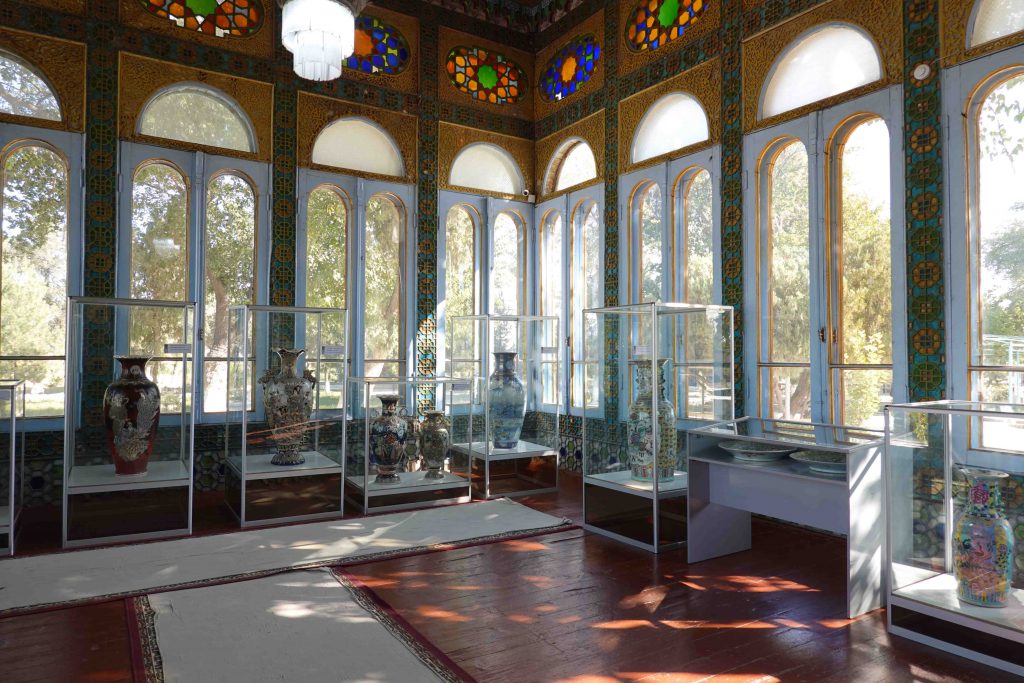
We stopped at the Ark Citadel.
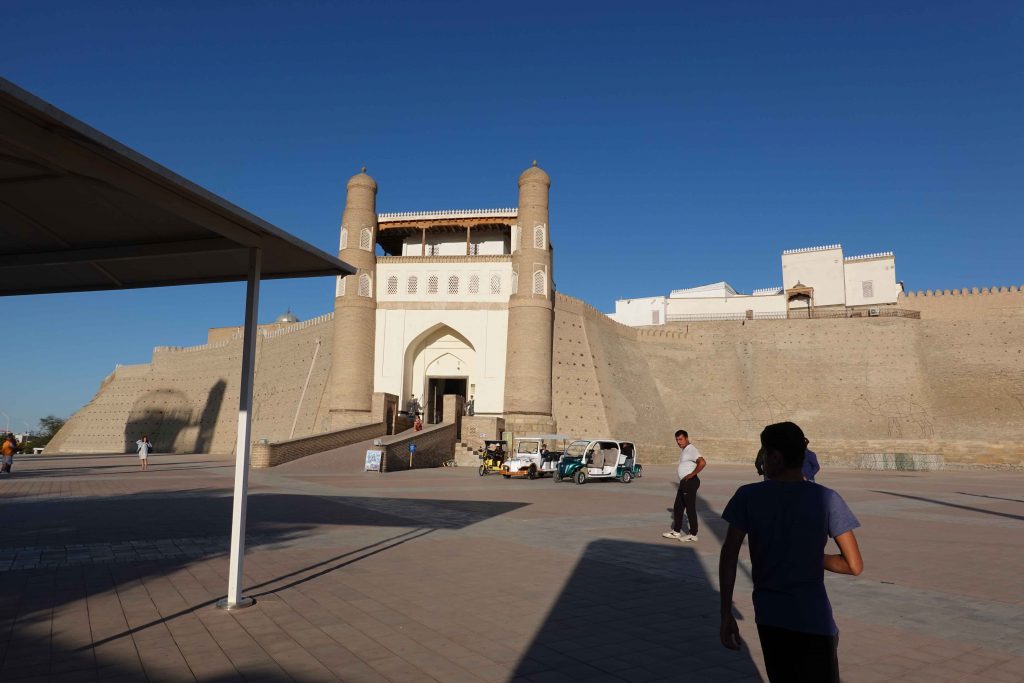
“The Ark, a royal town-within-a-town, is Bukhara’s oldest structure, it was home to the rulers of Bukhara for over a millenium. The Ark is as old as Bukhara itself. The founding of the original fortress is blurred in antiquity, but it was certainly the focus around which developed the medieval town. Archaeologists believe The Arc to have first been built sometime between the 5th and 6th centuries ad. The original structure covered a roughly rectangular site of some 3ha and included a palace, Zoroastrian fire temple, administrative areas and guardrooms; the main functions of the town all took place within these city walls so that they could more easily be defended in the case of attack.” http://uzbek-travel.com/about-uzbekistan/monuments/the-ark-citadel/
The oldest surviving part of the Ark is the Reception and Coronation Court. Its roof fell in during the 1920 bombardment by the Red Army. The last coronation to take place here was Alim Khan’s in 1910. Now we have a regal Trish on the throne:
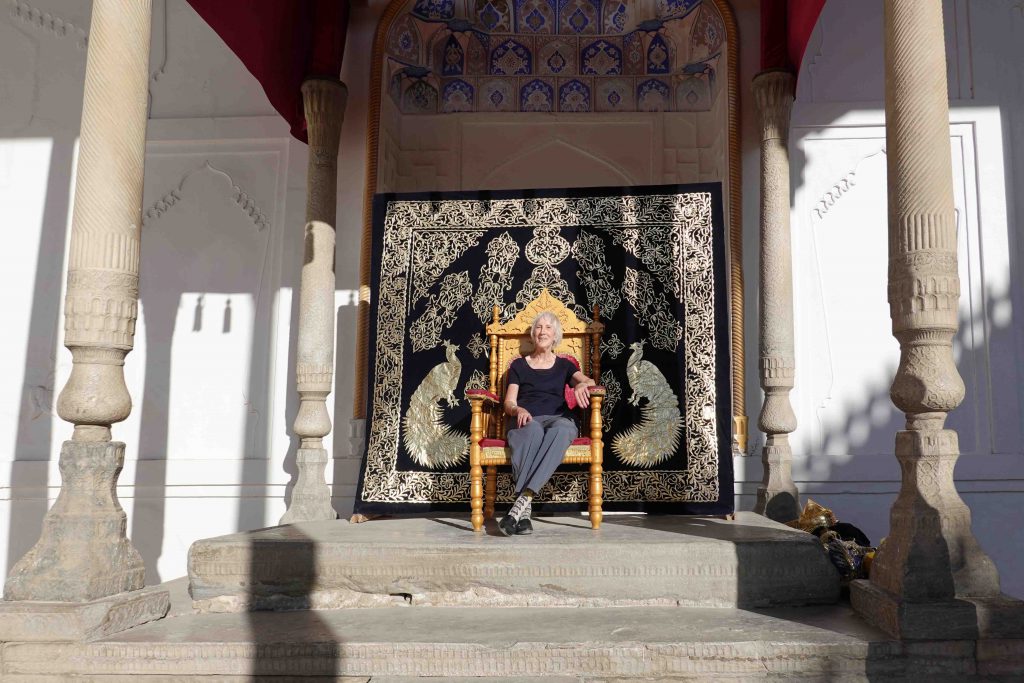
Dinner was a couple of minutes walk away from our hotel, at Old Bukhara. It is owned by Sharif Sharipov, who was a famous Uzbek soccer player.
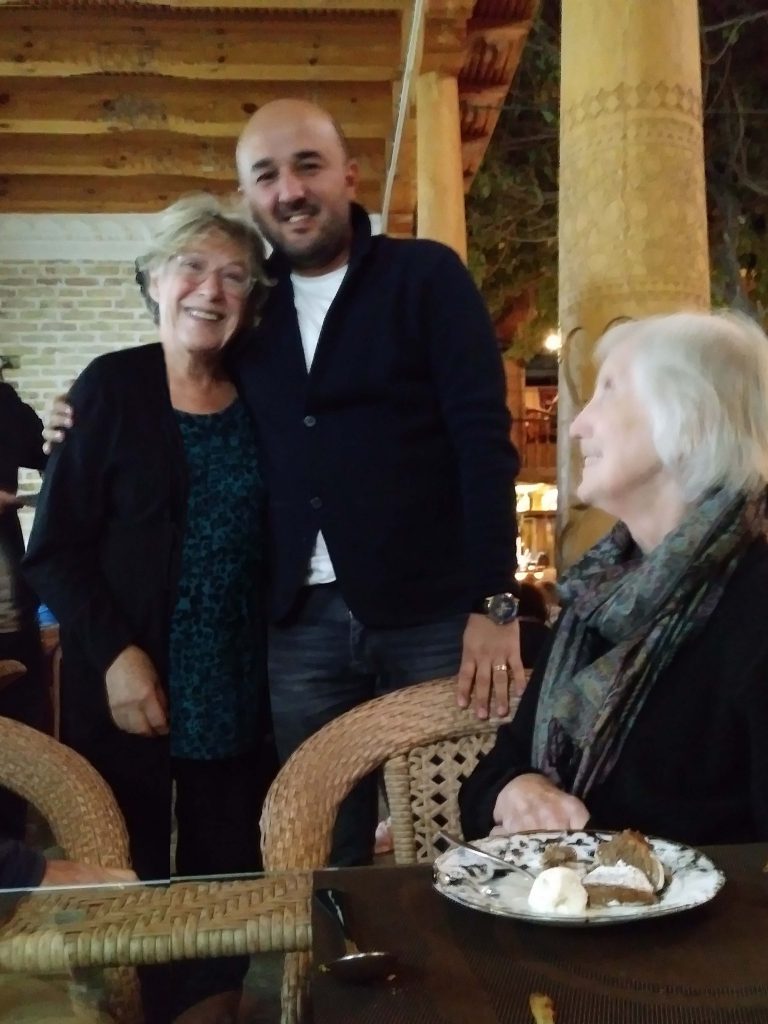
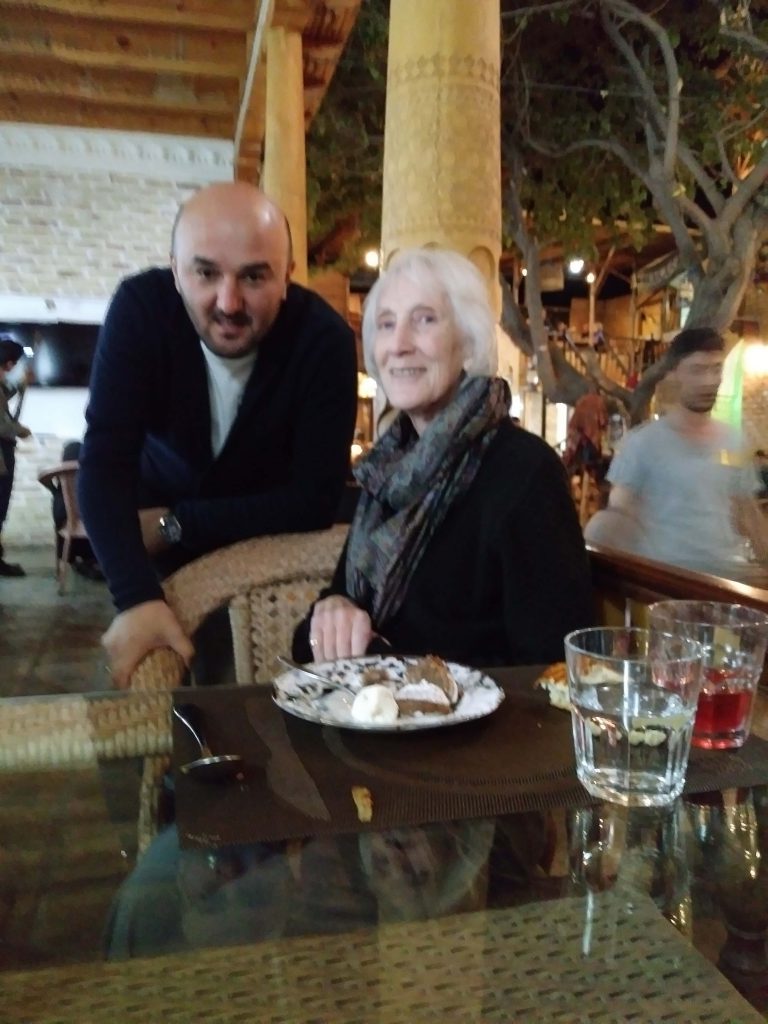
Bukhara – Oct. 2
ElderTreks brochure: One of the grandest of Uzbek centers, Bukhara is an open museum with many mosques, madrassahs and a grand minaret. We spend the day visiting some of the finest examples of Islamic Architecture in the world, where exquisite tile and mosaic work complements the beautiful brickwork; it is no wonder this city is a World Heritage Site. Our visit includes the Lab-e-Khauz Complex with the Nadirkhon Devanbegi Madrassah, the Mogak Attari Mosque and the Poi Kalon Minaret. We also visit the Madrassahs of Aziz Khan and the Ulugbek Ark Fortress, the residence-cum-army headquarters of the Bukharan Emirs that houses an interesting collection of objects from those days and the Mausoleum of Ismail Samanid, which features some of the best 10th century brickwork, with a marked Persian influence. We conclude the day with a visit to Sitora-I-Mokhikhosa, the summer residence of the Emir. Overnight in Bukhara: Asia Hotel.
Here’s where we went today: Ismail Samani Mausoleum (because of the way the bricks are laid, this building changes color depending on the time of day); Chashmai Ayub; Bolo Hauz Mosque; Ulubek Madrassah; Khanaka Nodir-Divanbegi and Lyabi Hauz; Abdulian Khan Madrassah, and one other–I didn’t get the name.
I’m not going to post a picture of each place, just a few of the ones I like the best:
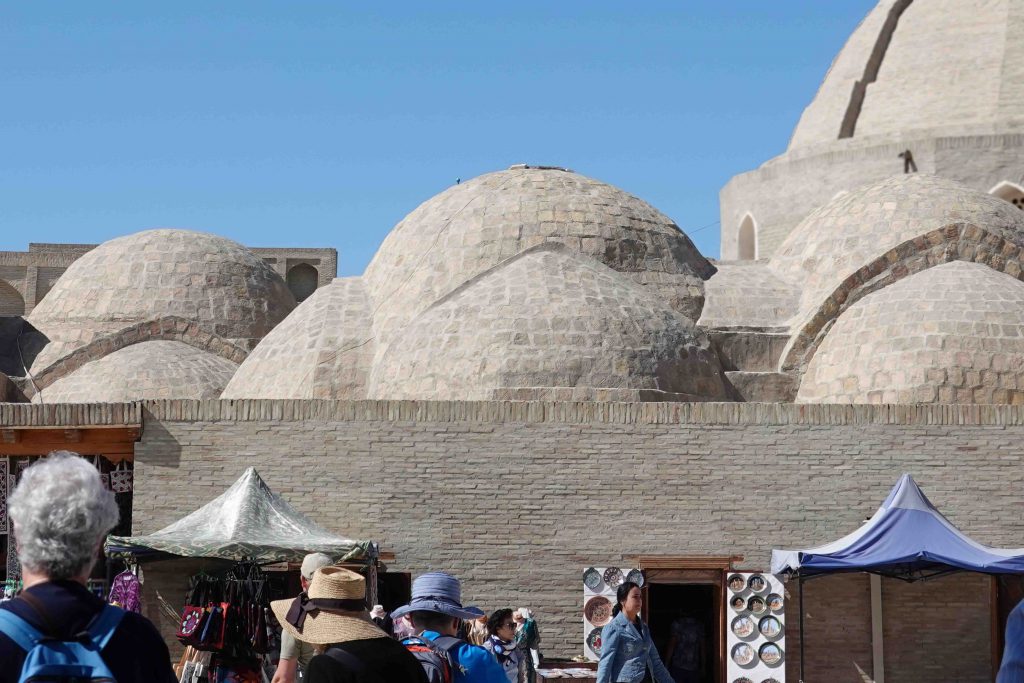
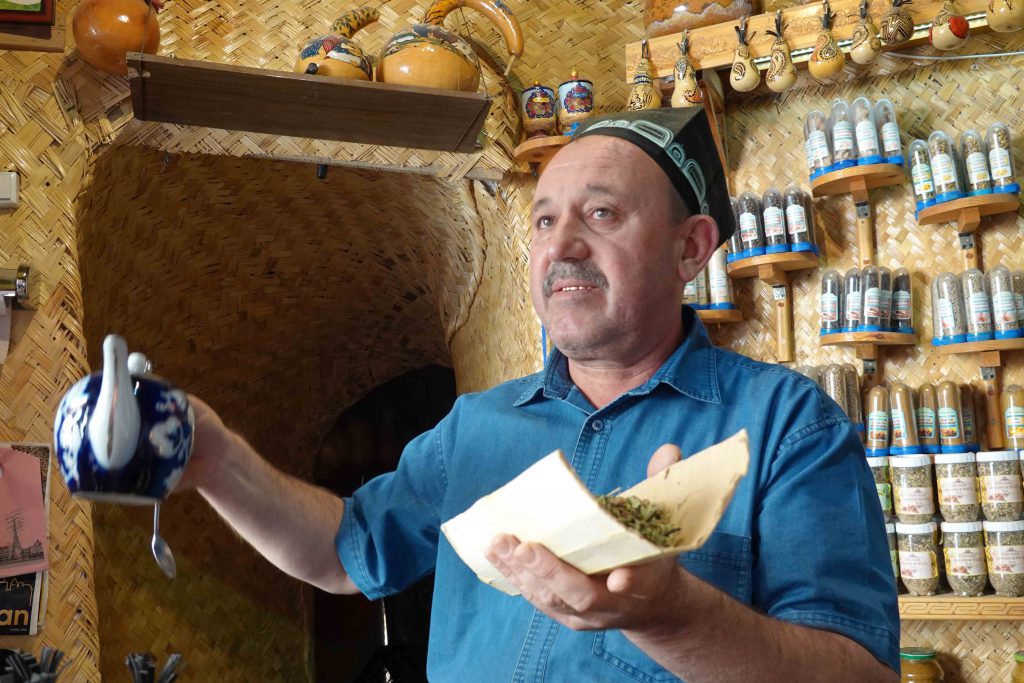
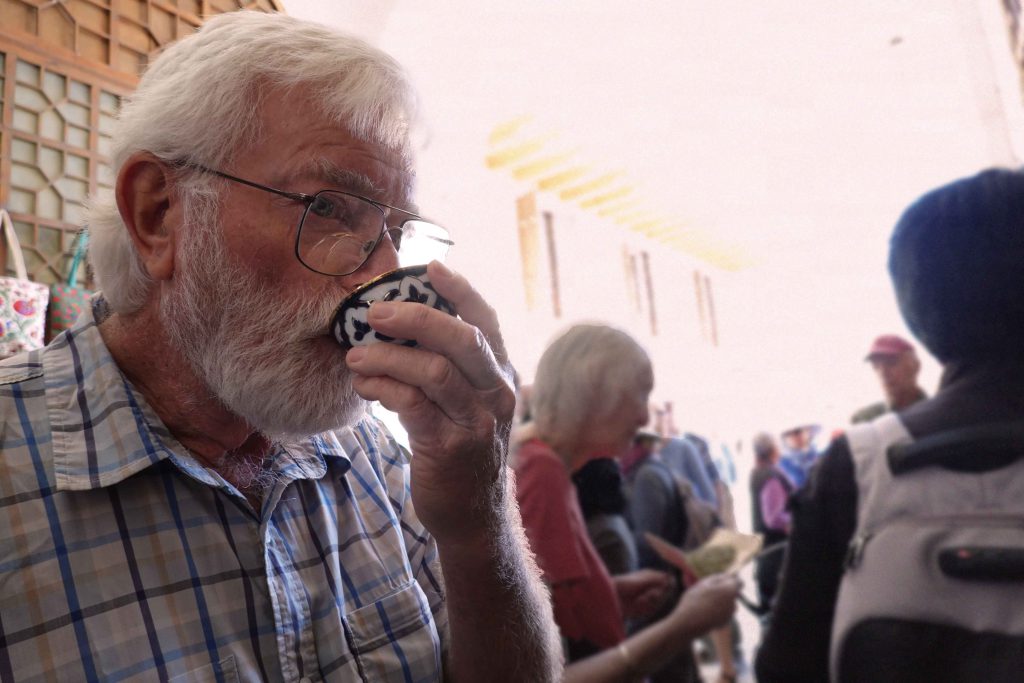
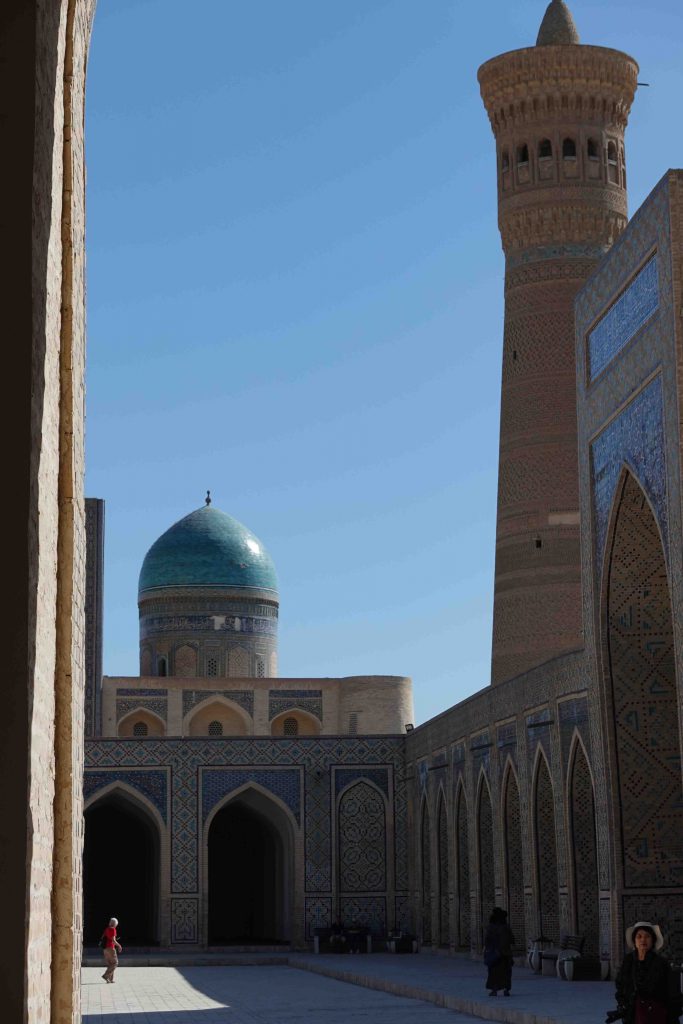
The sky wasn’t really like this, it just went in curves when I reduced the size for this blog.
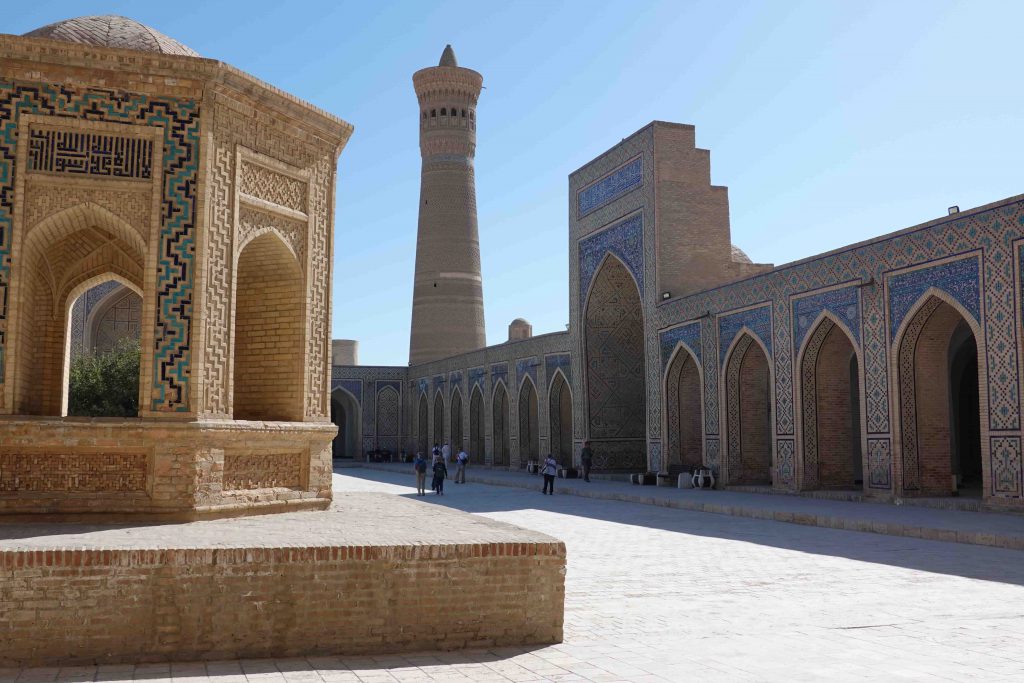
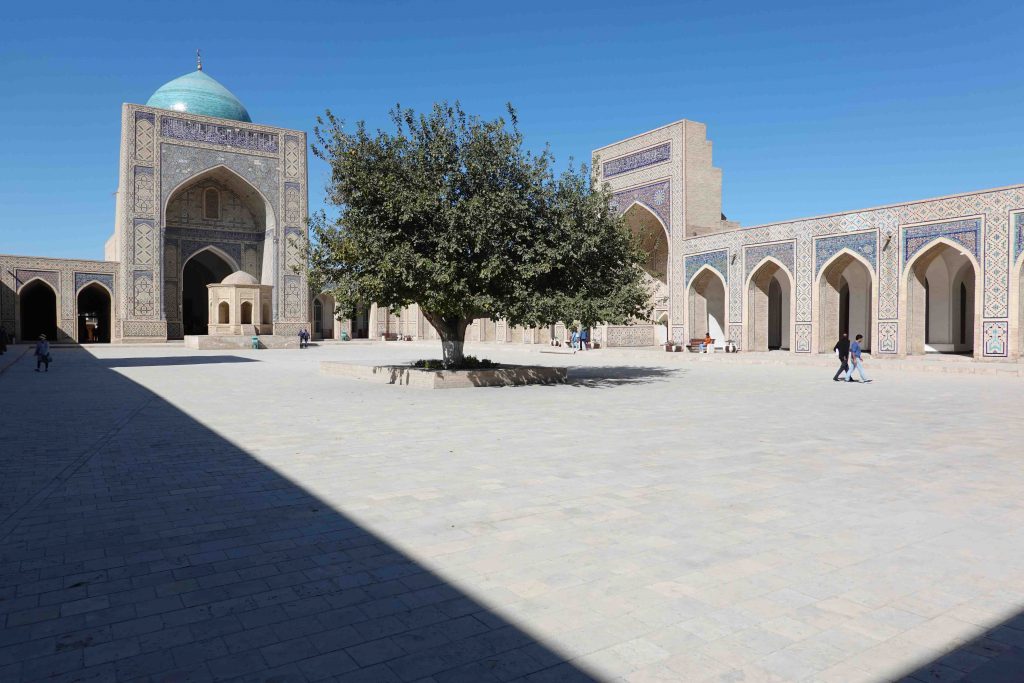
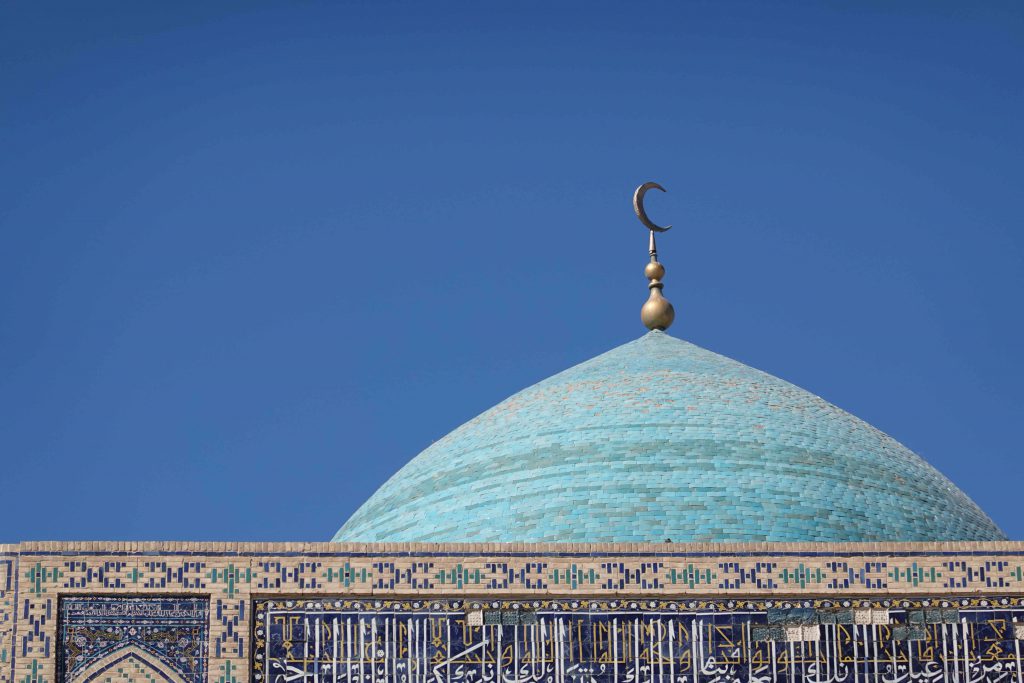
Lunch was at Old Bukhara. The bread was really tasty and chewy, the best of the trip.
Elaine and I went back to the bazaar and did some shopping in the afternoon–I bought a couple of blouses and some pretty, airy silk scarves.
On the way to dinner, we stopped at a park that had a statue of Hoja Nasruddin, known all along the Silk Road for his wisdom and wit. He is said to have lived and been born in Bukhara.

Then what was called a puppet show but it also had people in it interacting with the puppets. Was a sweet story about a marriage with some music, singing and dancing.
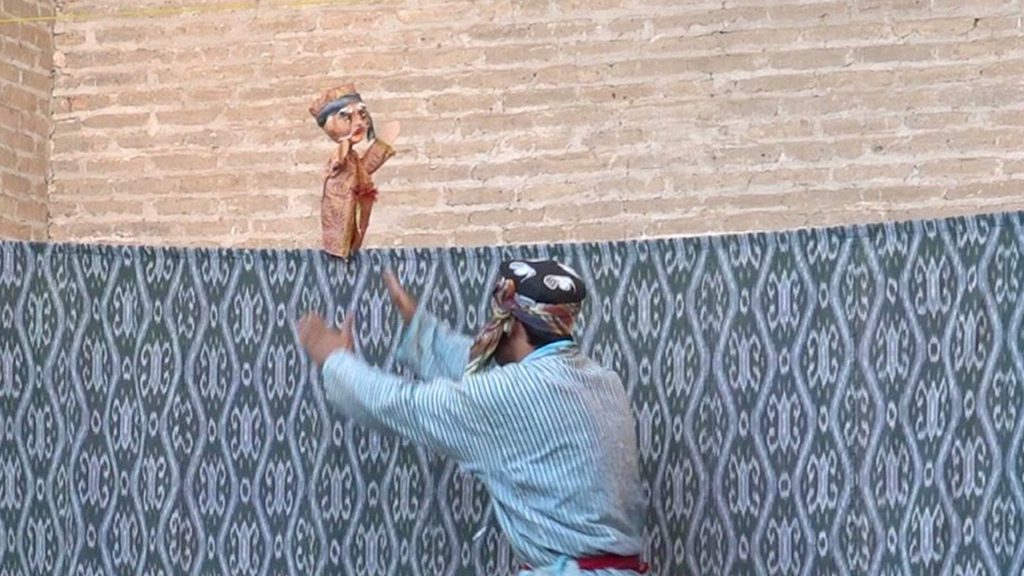
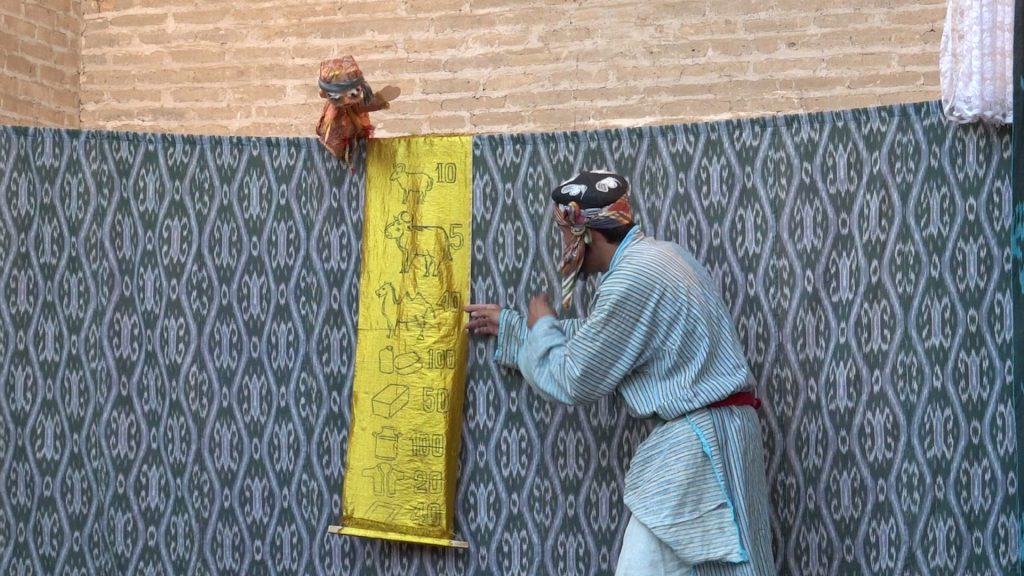
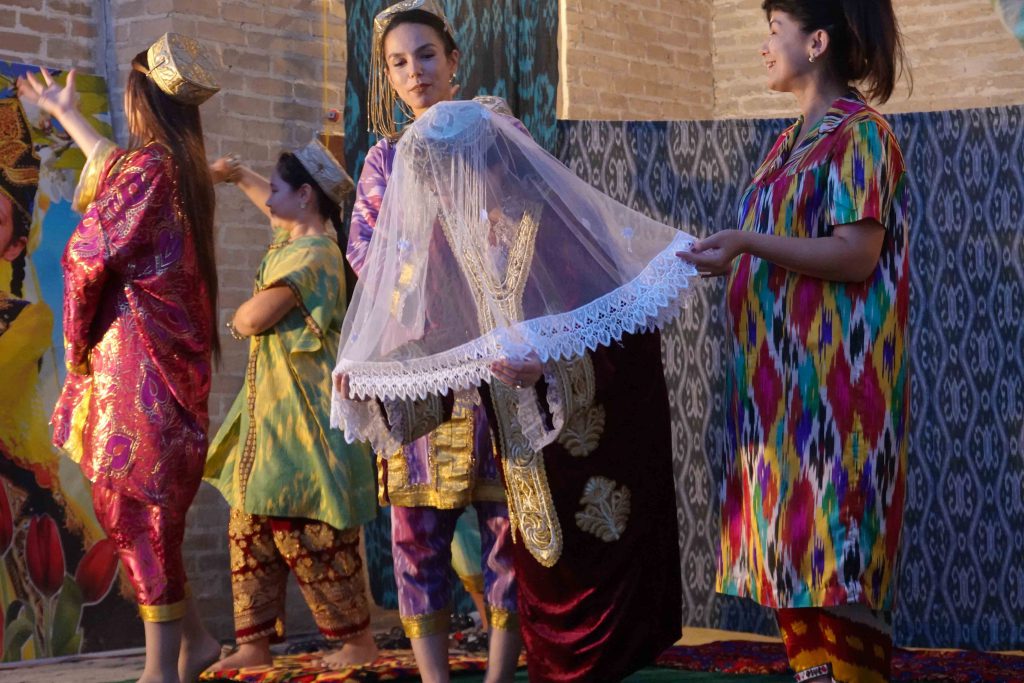
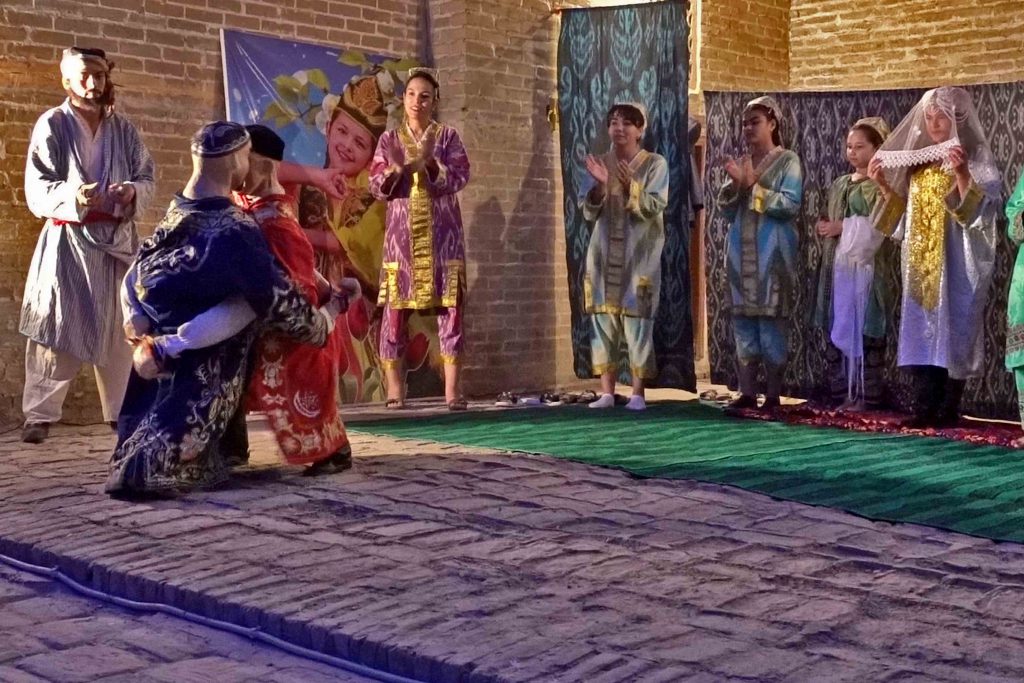
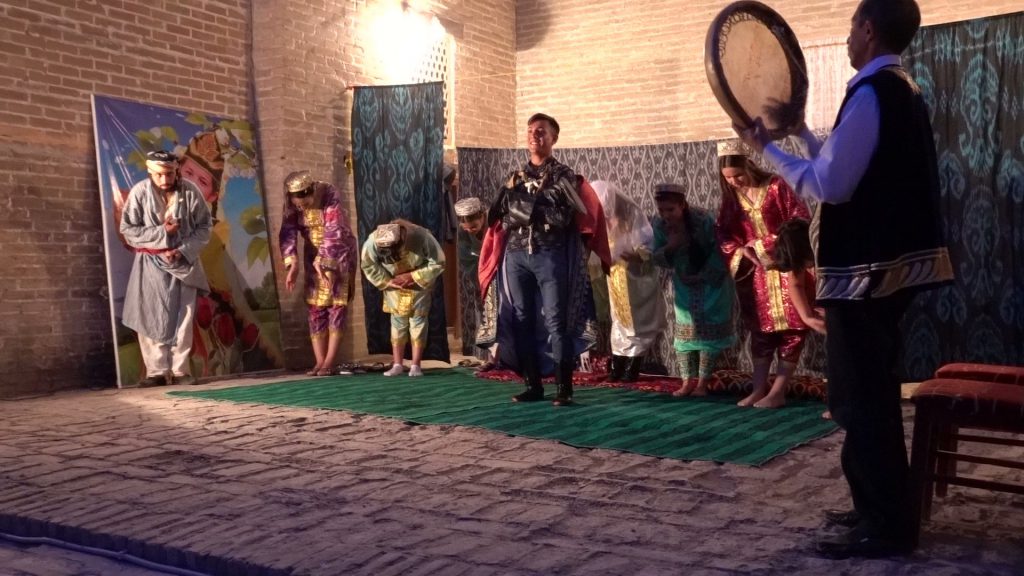
O.K. dinner, nothing special.
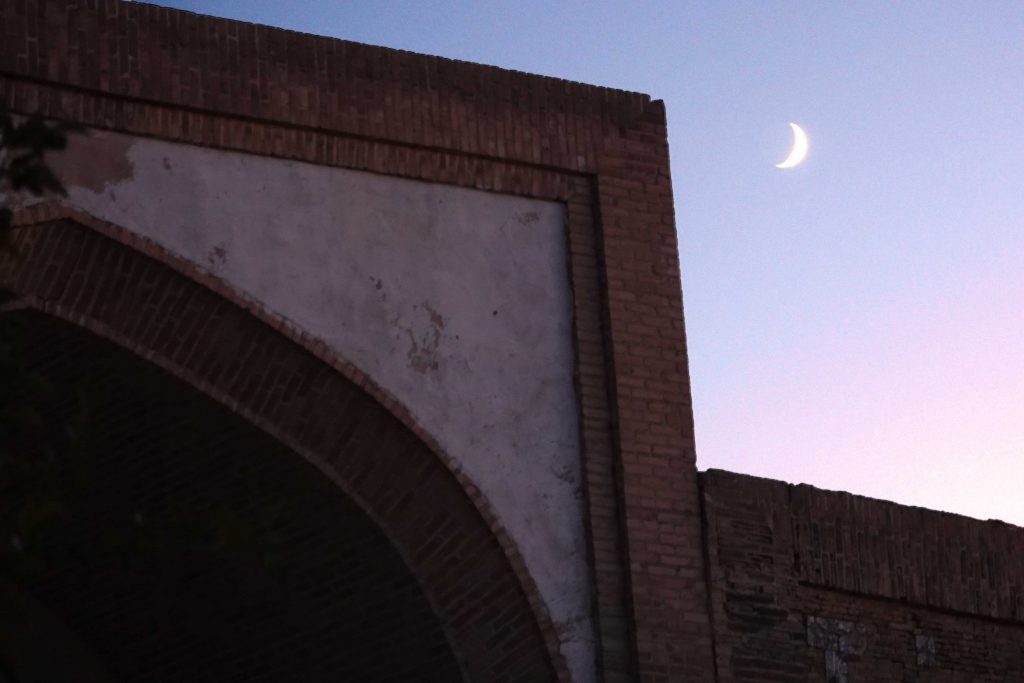
To Kiva – Oct 3
ElderTreks brochure: We have an early morning departure for our full day’s drive to Khiva (480 KM / 300 miles.) Overnight in Khiva: Asia Hotel.
On the way out of town stopped at Chor Minor for photos and bit of history.
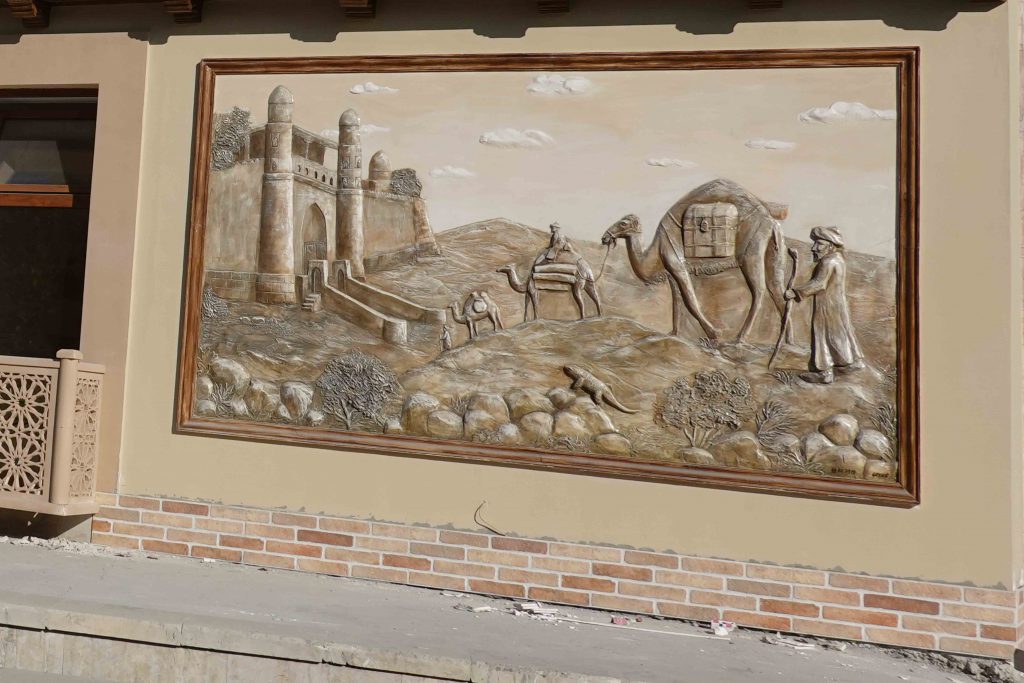
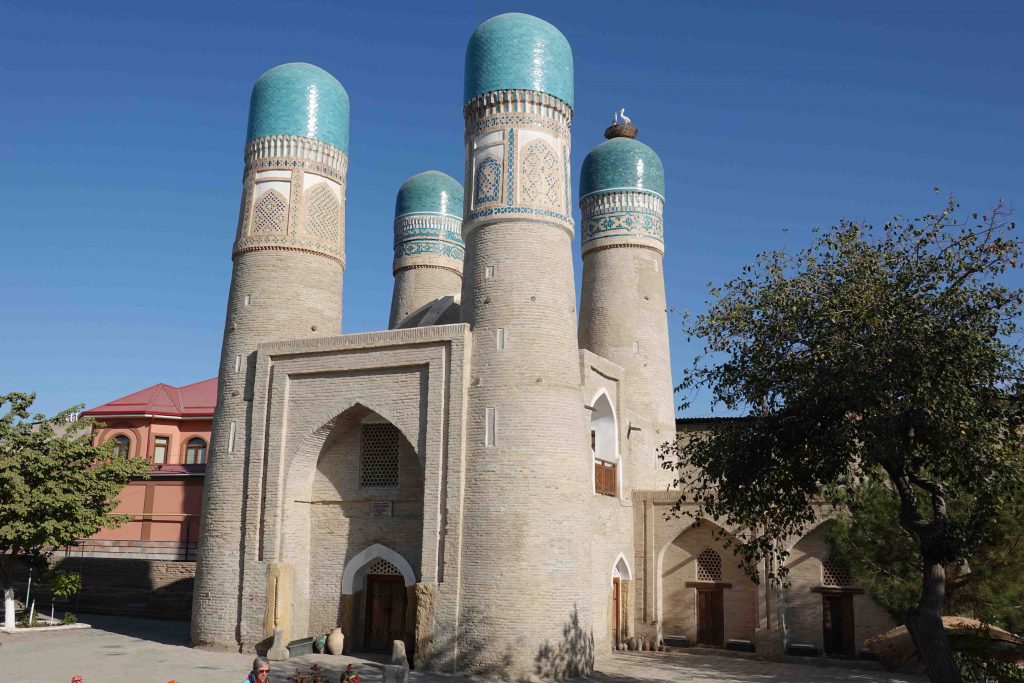

One of our group discovered she’d left her purse in her bedroom at the hotel, it had been behind her backpack and she didn’t see it when she grabbed the backpack and left the room. Fortunately, we were only five minutes away and the bus driver went back to the hotel and retrieved it.
During our first stop “to pick flowers” as Helen puts it, our drivers needed to fix the steering. We’d just come off some seriously bad road and onto a good surface.
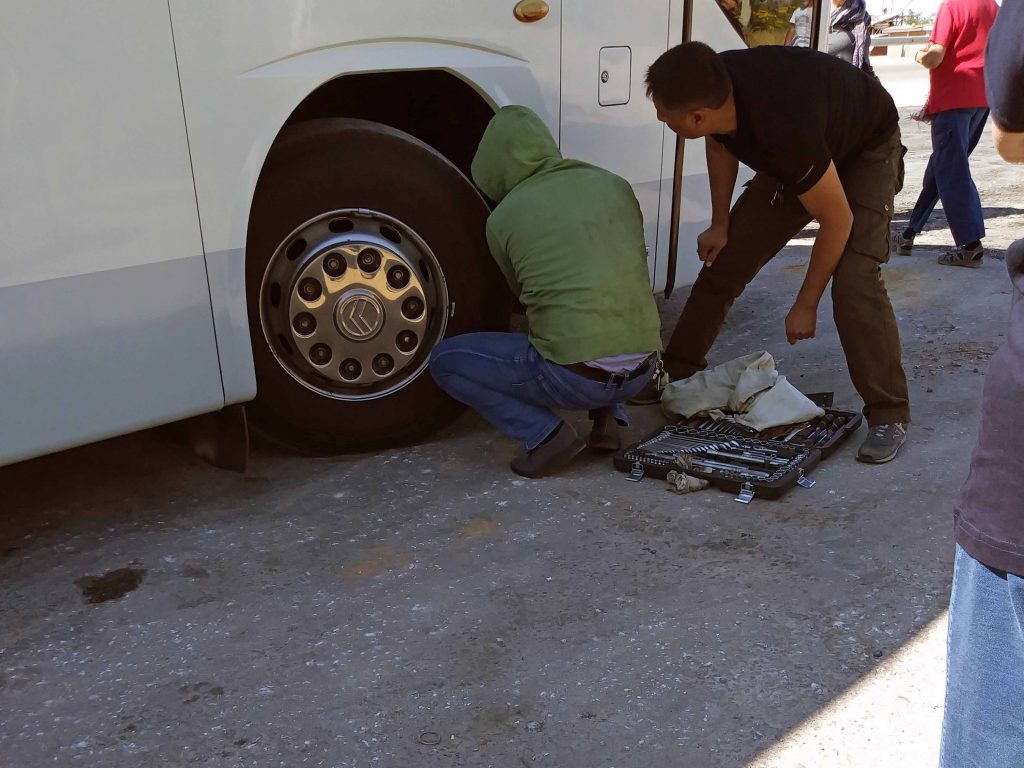
On the drive, we left “just” arid land and came into semi-desert, then a little bit of true desert. I was dozing and missed that.
Lunch was a boxed one and there was plenty to eat.
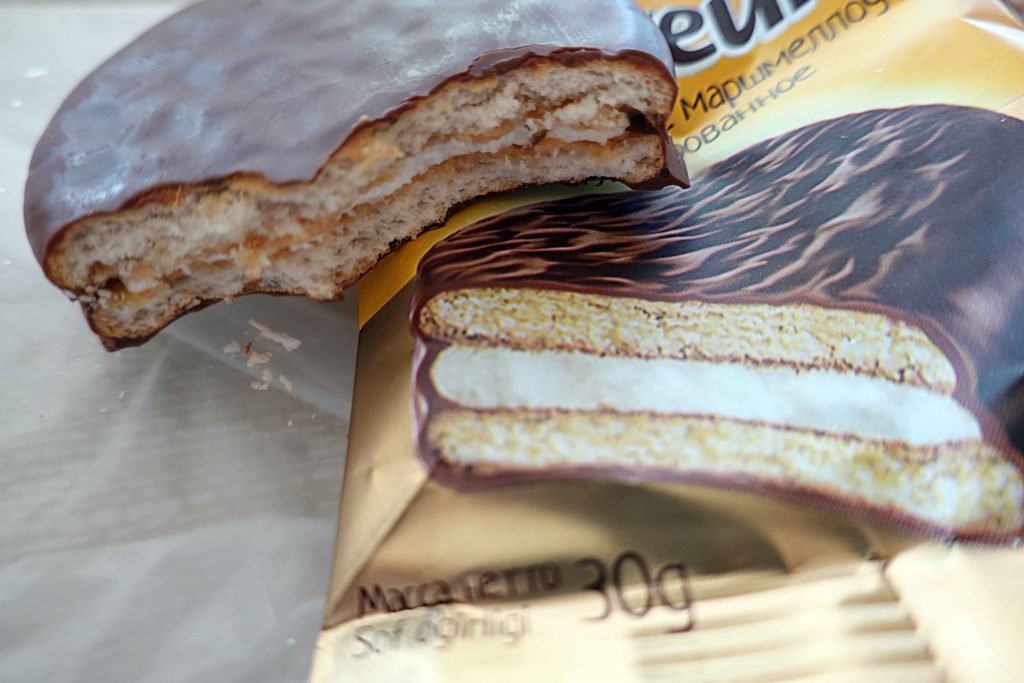
We arrived in Kiva at right at 6 tonight. Leroy and I again decided not to go out with the group for dinner and had soup and salad in the hotel restaurant. I chose the cheese soup, it said it had chicken in it but instead it had teeny tiny bits of beef. Didn’t matter, it was delicious and not cheesy at all. Leroy had a Greek salad. We don’t like eating late then going back to our room and falling into bed on a full tummy, unless there is something else going on such as entertainment, or an unusual restaurant/food. We have plenty of other times to be sociable and visit with the other ElderTrekkers.
The general consensus was the meal wasn’t worth the walk, the restaurant was more like a cafeteria, but the lights on the minarets and other buildings looked nice.
Kiva – Oct. 4
ElderTreks brochure: Today we explore the world heritage site of Khiva, a city where time has stood still in the age of the Arabian Nights. Our visit starts with the main site of Itchan Kala followed by Kalta Minor, the Kunya Ark, the Rakhimkhon Madrassah, the Mausoleum of Pakhlavan Makhmud, the Friday Mosque and the Tashauli palace and harem. Overnight in Khiva: Asia Hotel.
Here is the view this morning from my bedroom window of the Tosh Gates and part of the wall of the city of Kiva. Khiva is divided into two parts, the older Ichan-Kala (meaning within the wall) built over a period of 2,000 years, and the modern Dichon-Kala (outside the wall). This oasis on the old Silk Road used to be the last stopping spot for caravans before crossing the desert to Persia/Iran.

I’ve been meaning to mention and keep forgetting, and this has been true throughout our trip, is there often are variations in the spelling of names of places and people, all sound similar, and all are correct.
Once again, I’m not going to put up a picture and description of everything we saw and learned, just what I found the most interesting.
Today started off cool, almost cold, but as the morning went on it warmed up until by 2 p.m. the shade was welcome.
Kalta Minor (means short minaret) doesn’t have a top. There are several legends why it was never finished, one is because Khiva’s ruler, Muhammad Amin Khan, climbed up there to see how things were progressing and saw it overlooked his harem. He had everyone involved killed, including the workers, who might have seen into the harem.
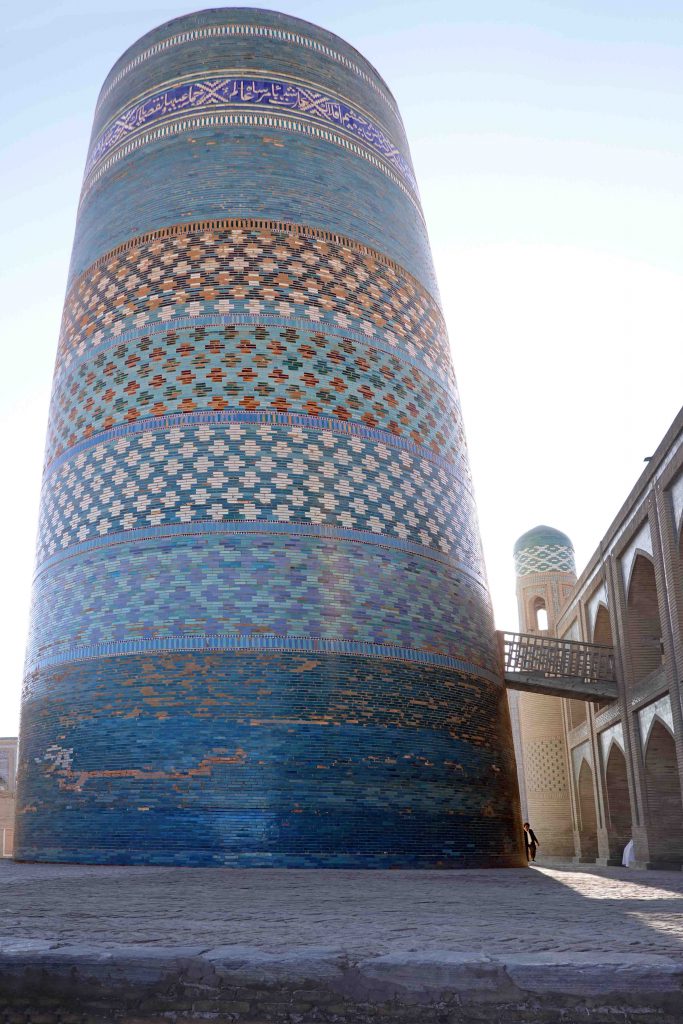
There is a lot of salt in the groundwater of Kiva. All water, even drinking water is salty (my porridge was this morning). Locals are used to it and don’t notice it–friends from Kiva asked Helen why her water was so sweet when they visited her.
The groundwater is close to the surface and soaks upwards, I could see the white bloom of it, mostly on the lower part of buildings. Unlike elsewhere that only needs plaster or similar, Helen pointed out that nails are used in some buildings in Kiva to hold tiles on to walls or else they’ll fall off within five to ten years. Unfortunately, the nails used back then are rusting and falling out. Maybe they’ll go to stainless steel.
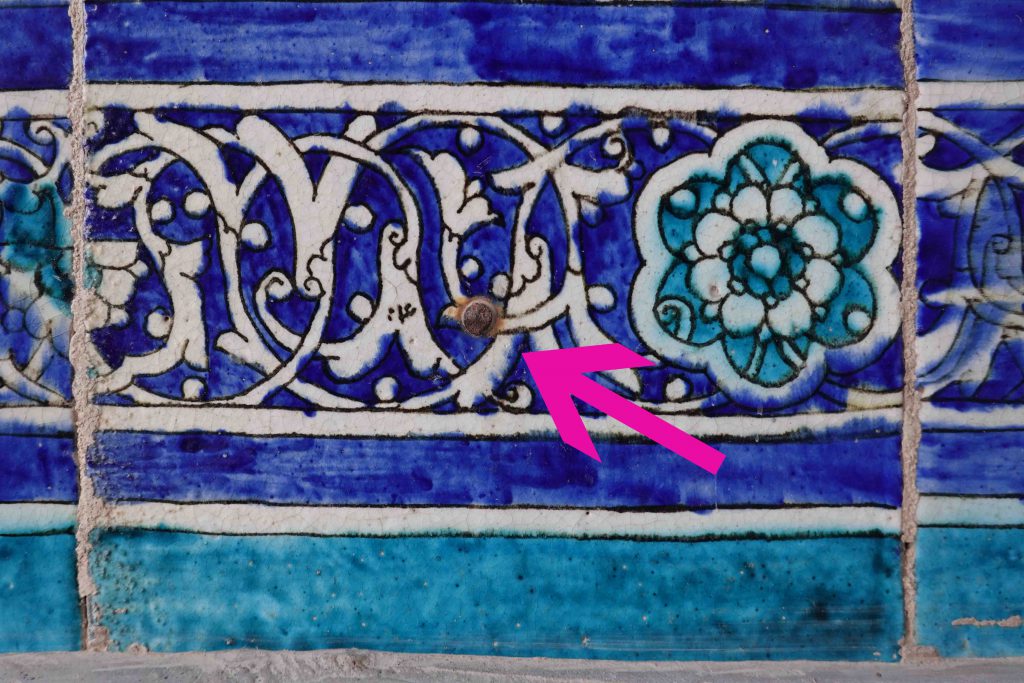
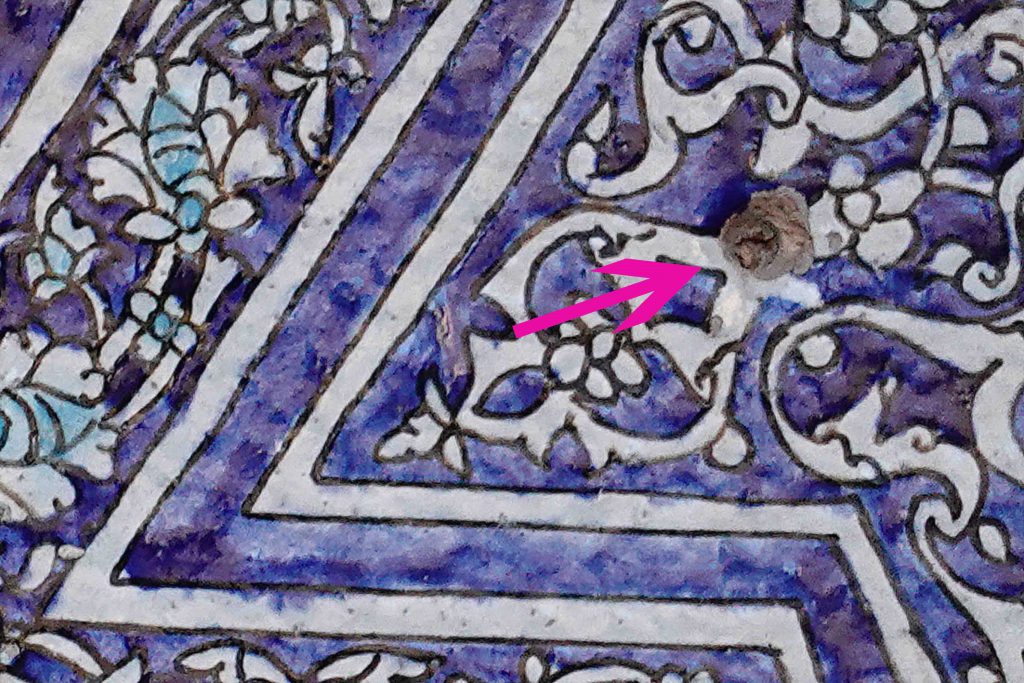
Inside the Kuhna Ark, the khans dispensed swift punishment–trials took an average of six to seven minutes. Which door you were led out of showed your fate: the left door meant not guilty and freedom, the right door meant imprisonment (if the prison was full they took them out into desert and left them to die), and the center door meant death.
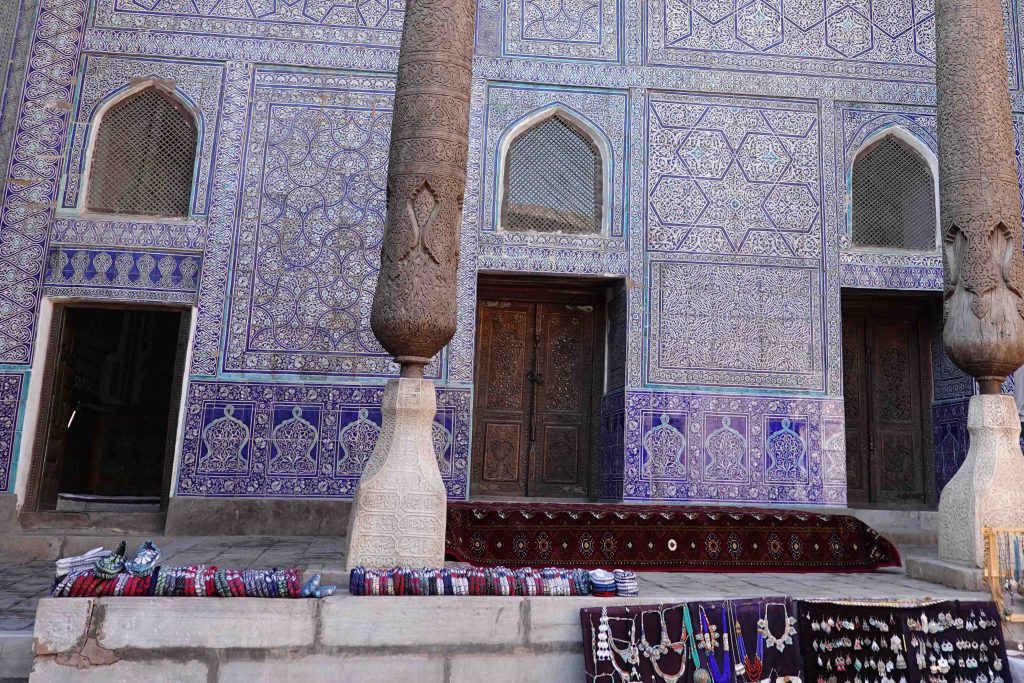
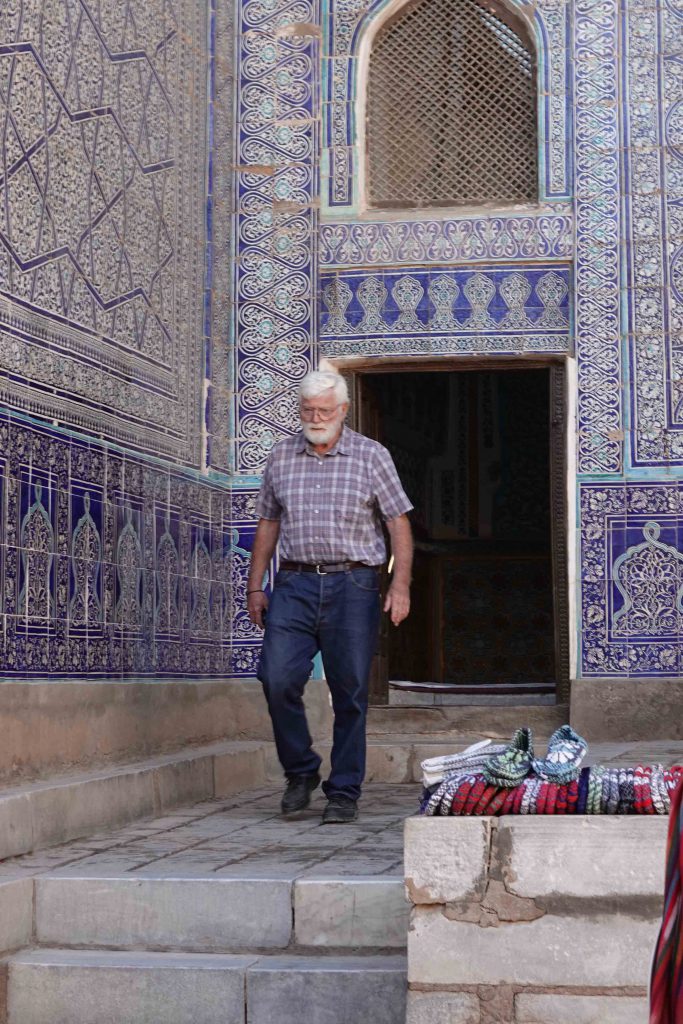
The sexy man in the photo below, Said Islam Khodja, was prime minister of Khiva from 1899 to 1913. The story goes that while in Russia he saw and fell in love with the Tsar Nicholas II’s wife, Alexandra Feodorovna, and asked if he could have her as a wife. The interpreter was horrified at such a request about his tsarina and refused to translate, even after being told to do so several times. Islam Khodja was mysteriously stabbed to death shortly after returning to Khiva.
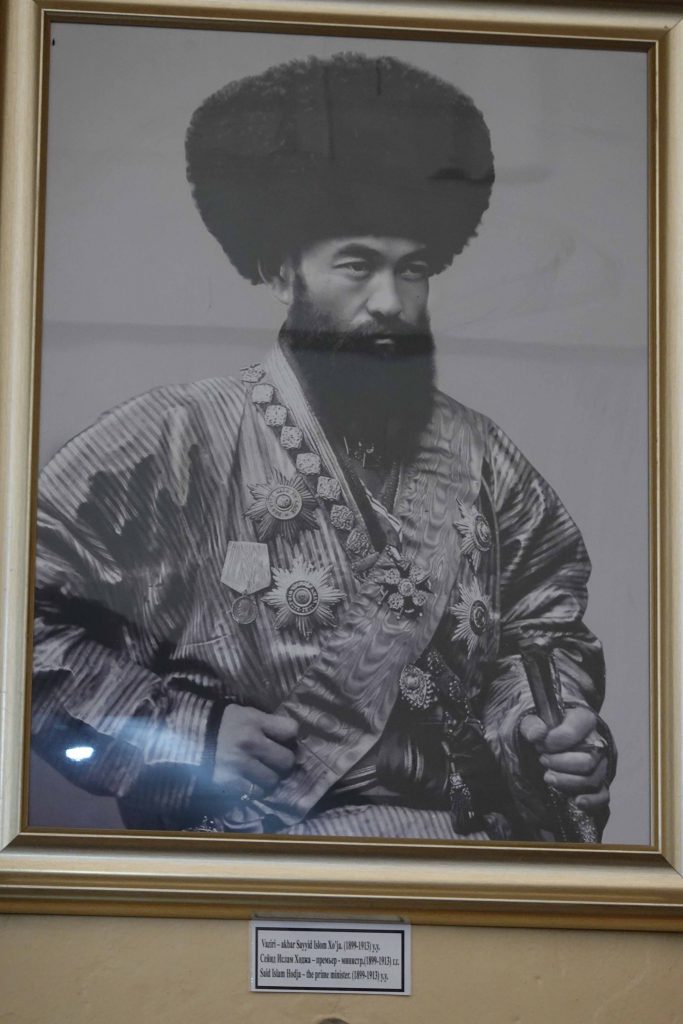
Islam Khodja was a modernizer who introduced new amenities to the city including a hospital, telegraph office, and non-parochial schools. https://www.orientalarchitecture.com/sid/1230/uzbekistan/khiva/islam-khodja-complex
Juma Mosque is a Friday mosque, the main mosque used by all on Fridays. Also spelled as Djuma Mosque, it has a covered courtyard providing a cool retreat from the desert heat and contains 212 wooden columns (half a dozen from the 10th Century) each with a different story to tell.
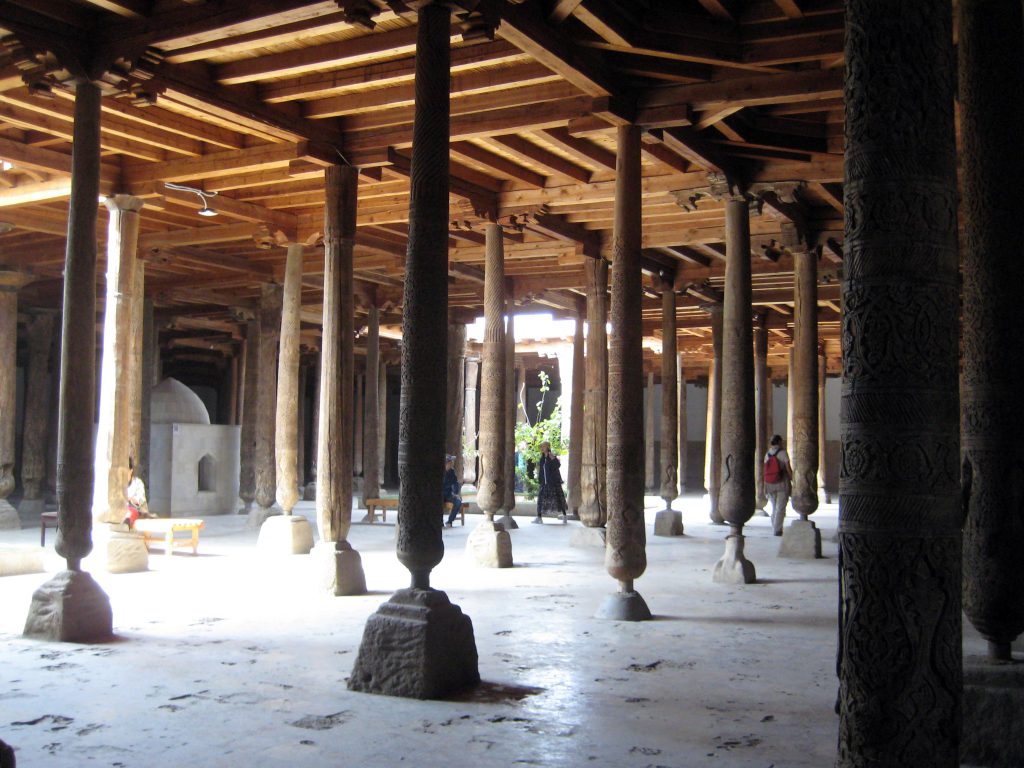
Have seen lots of pictures, statues, toys, postcards and so on of camels during this trip, but this is our first real live one:
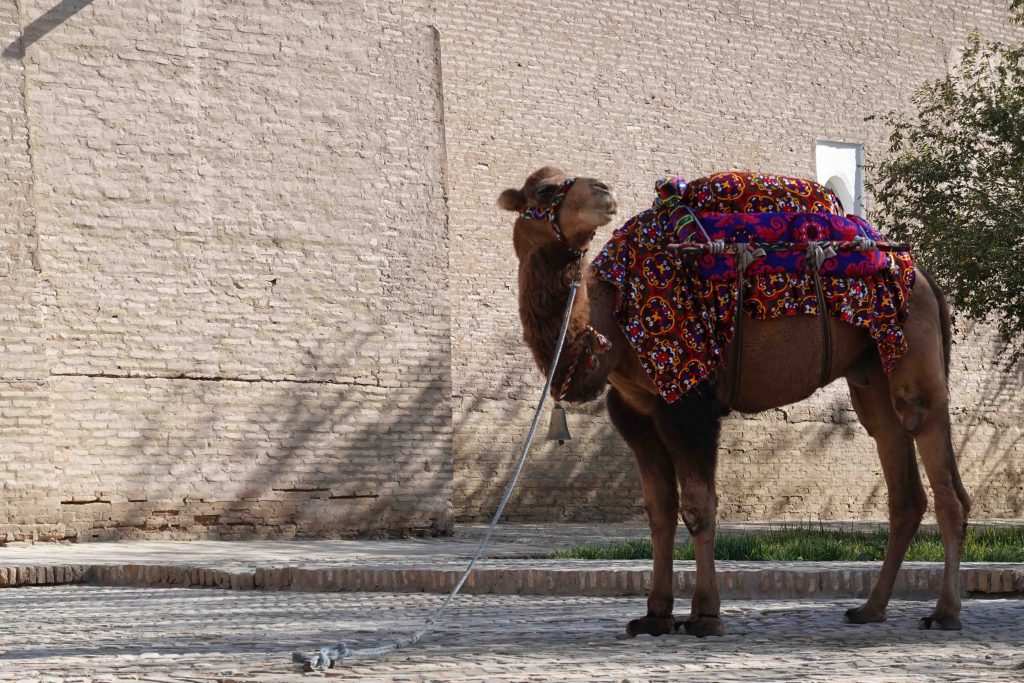
We were puzzled when Roger and Helen led us to a square and had us sit on benches. Then music started and we watched “The Amazing Jabborov family”. They really were amazing.
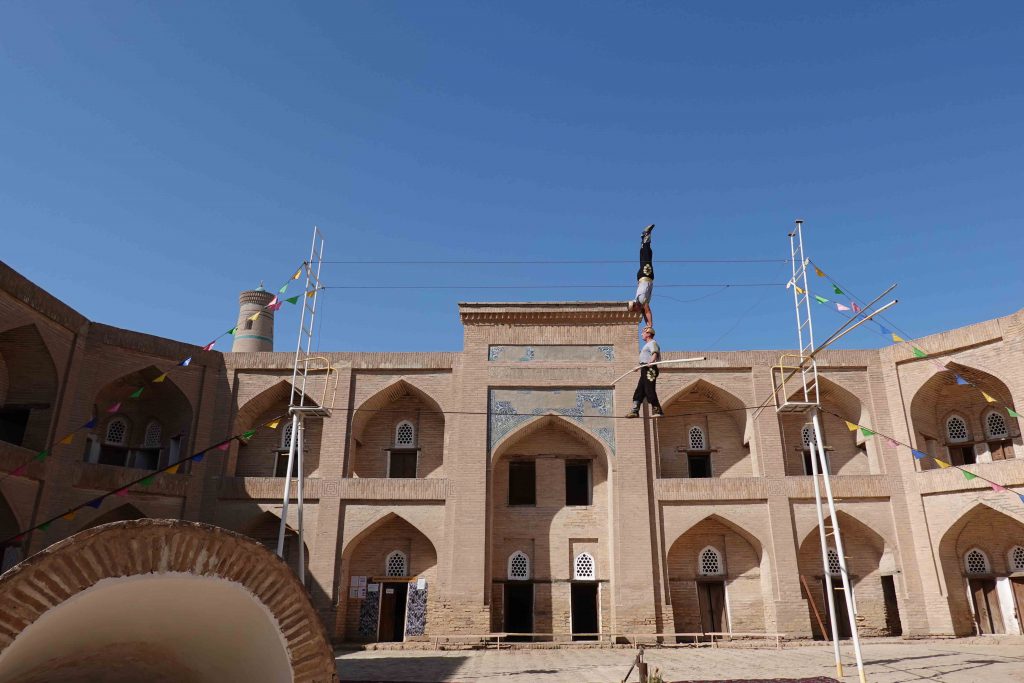
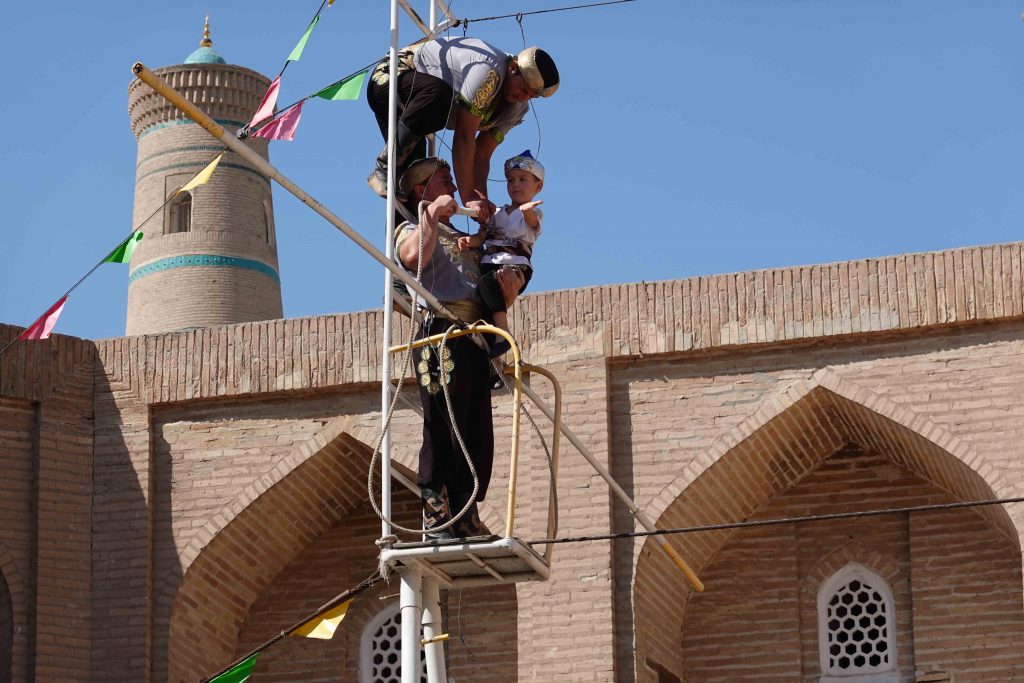
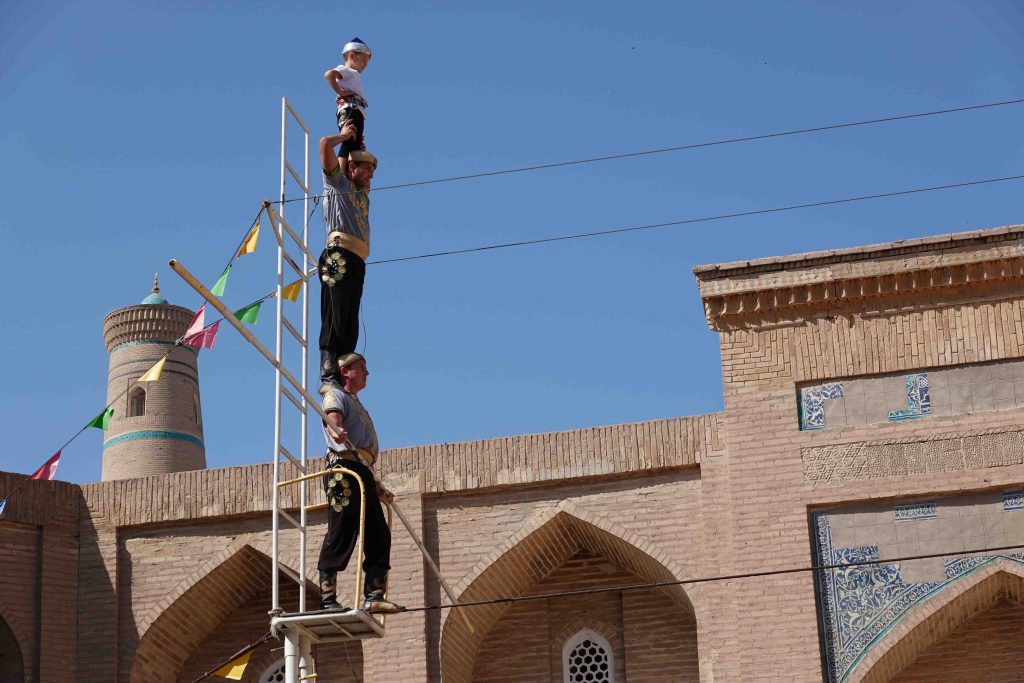
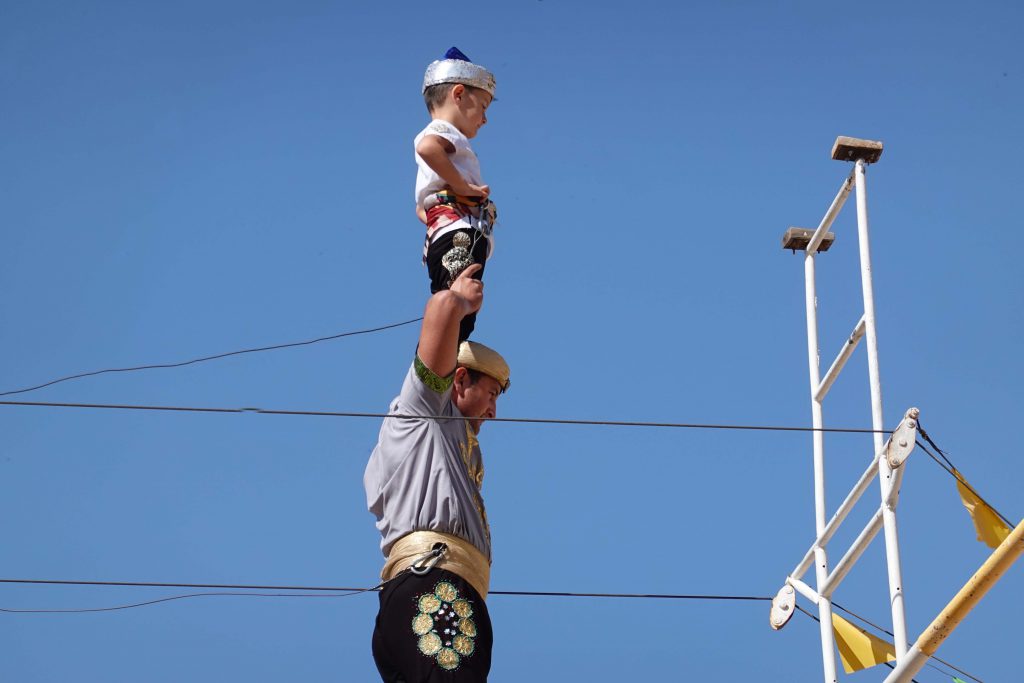
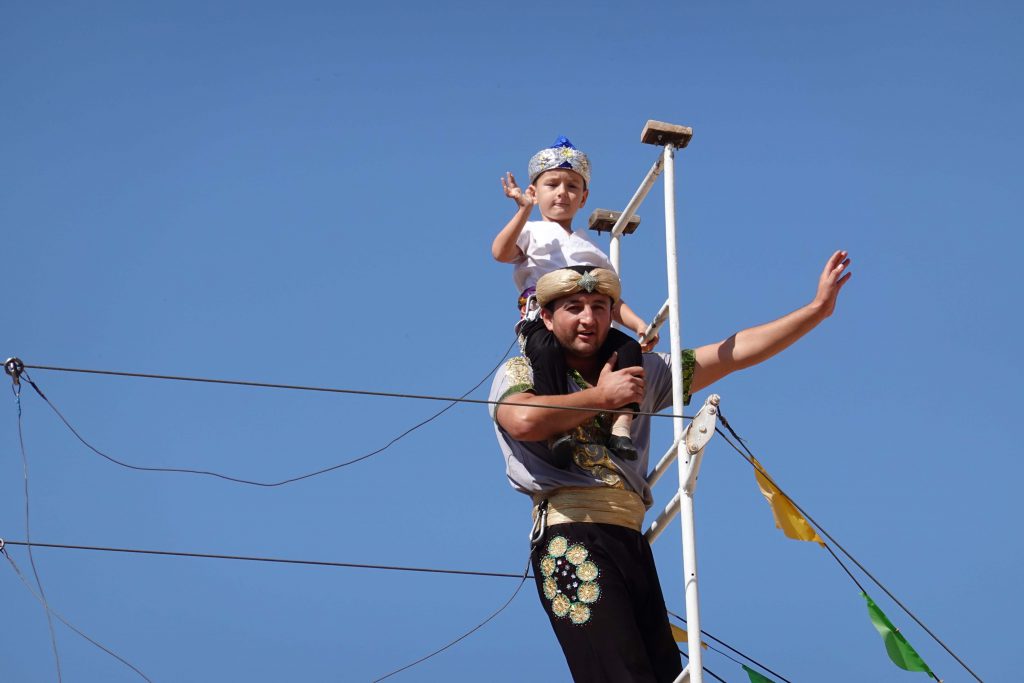
They ended up playing some tunes for us:
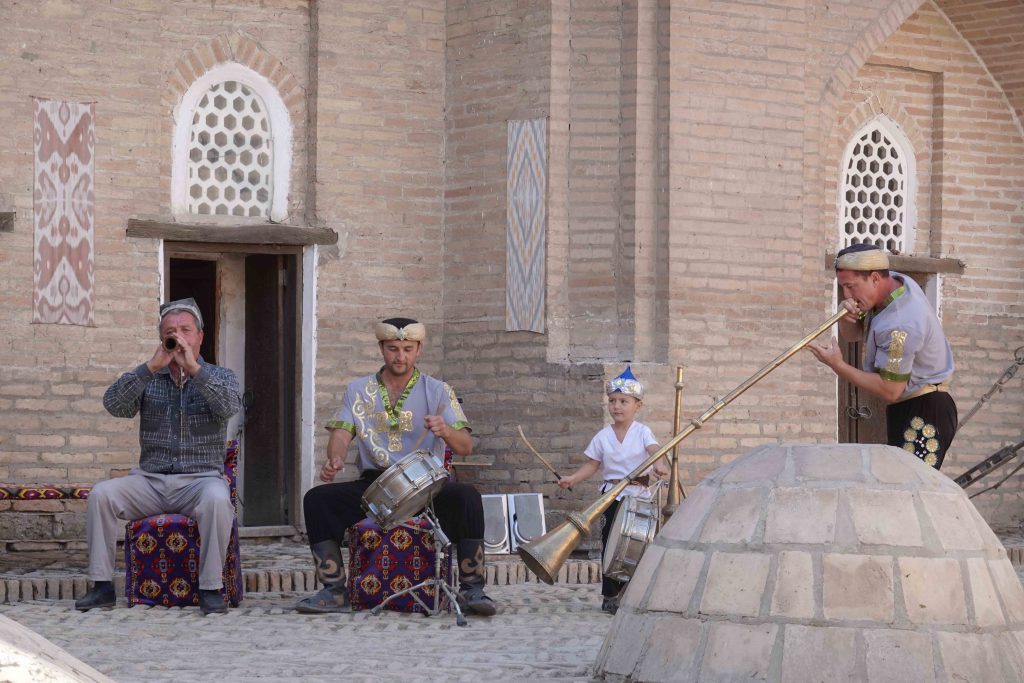
In the morning, early, we’ll be leaving to go into the final country on this tour, Turkmenistan, and internet service may not be available, or if it is, slow and intermittent so, if there are no more Posts for a few days, that’ll be why.
Tomorrow night, we camp at the Darwaza Gas Crater, the “Gateway to Hell”.
Next page: Turkmenistan
Previous page: Tajikistan
All pages: In Transit : Kazakhstan : Kyrgyzstan : Tajikistan : Uzbekistan : Turkmenistan : Notes after returning home : Q&A, Comments
